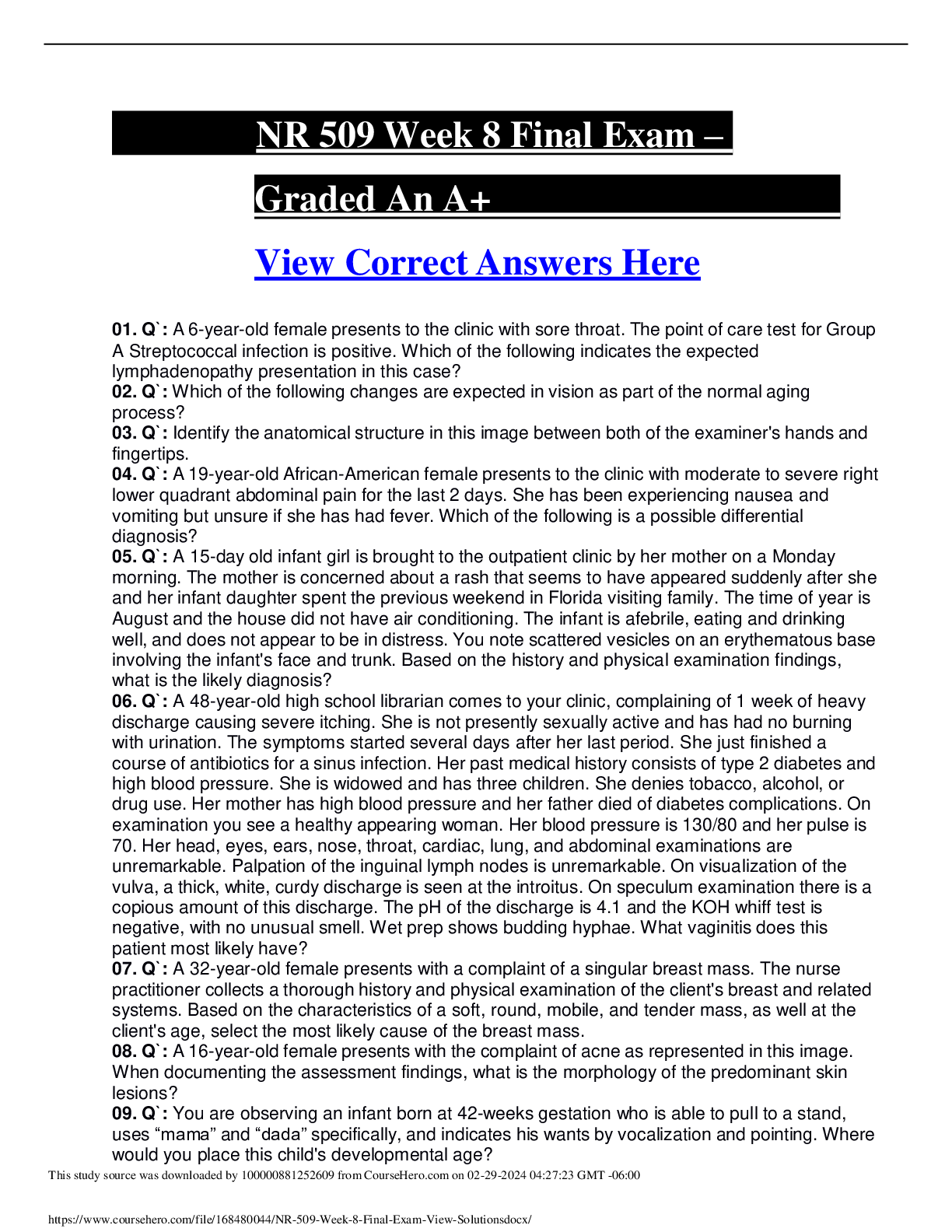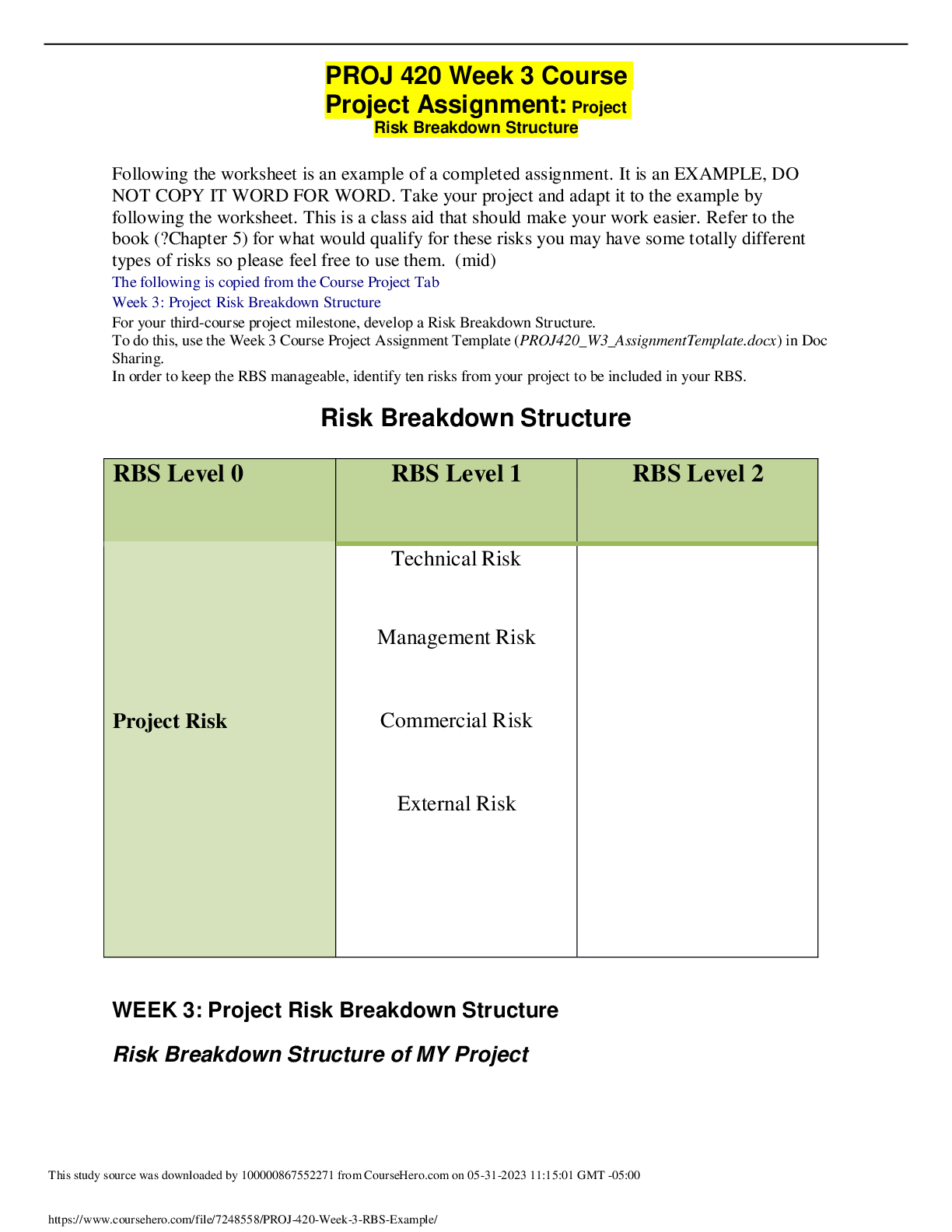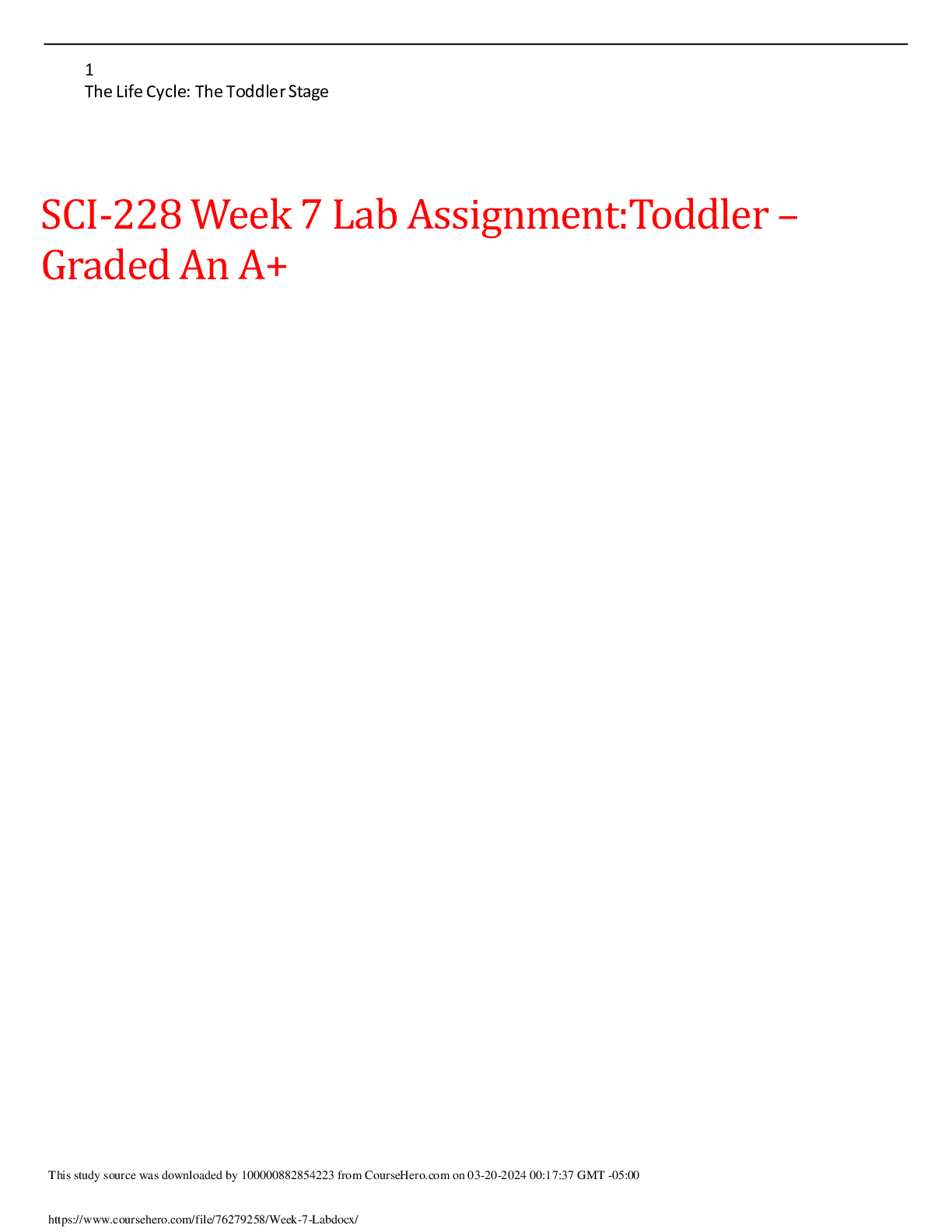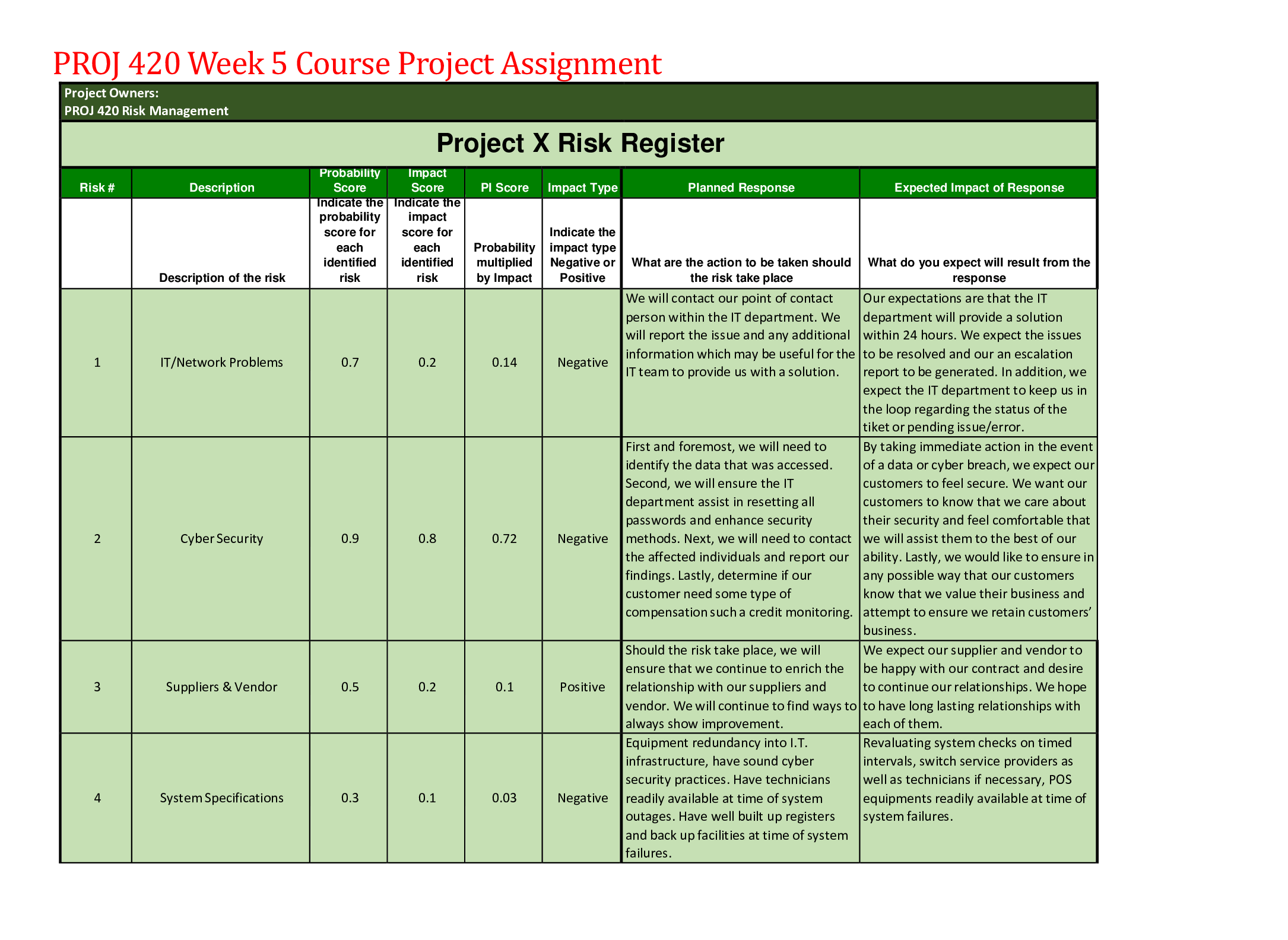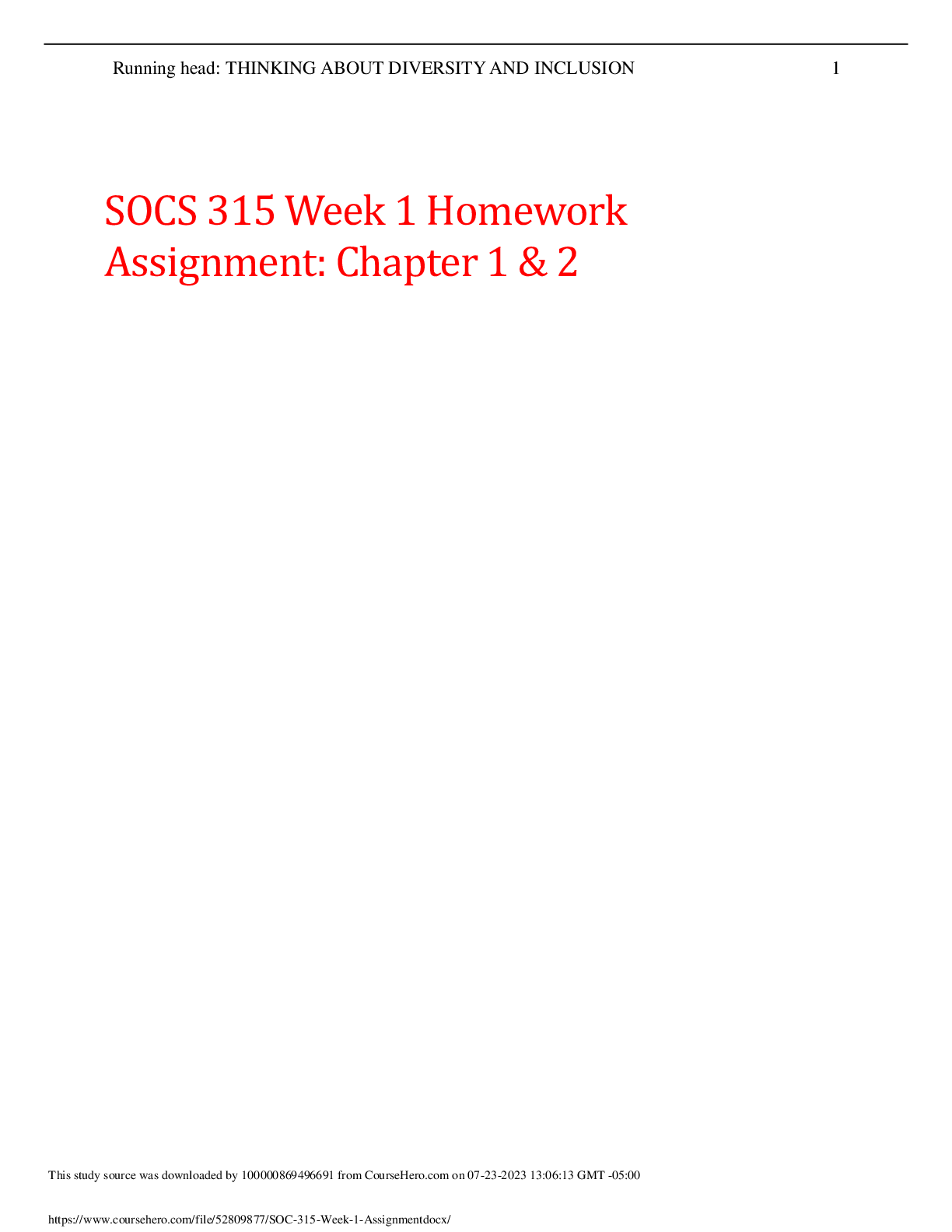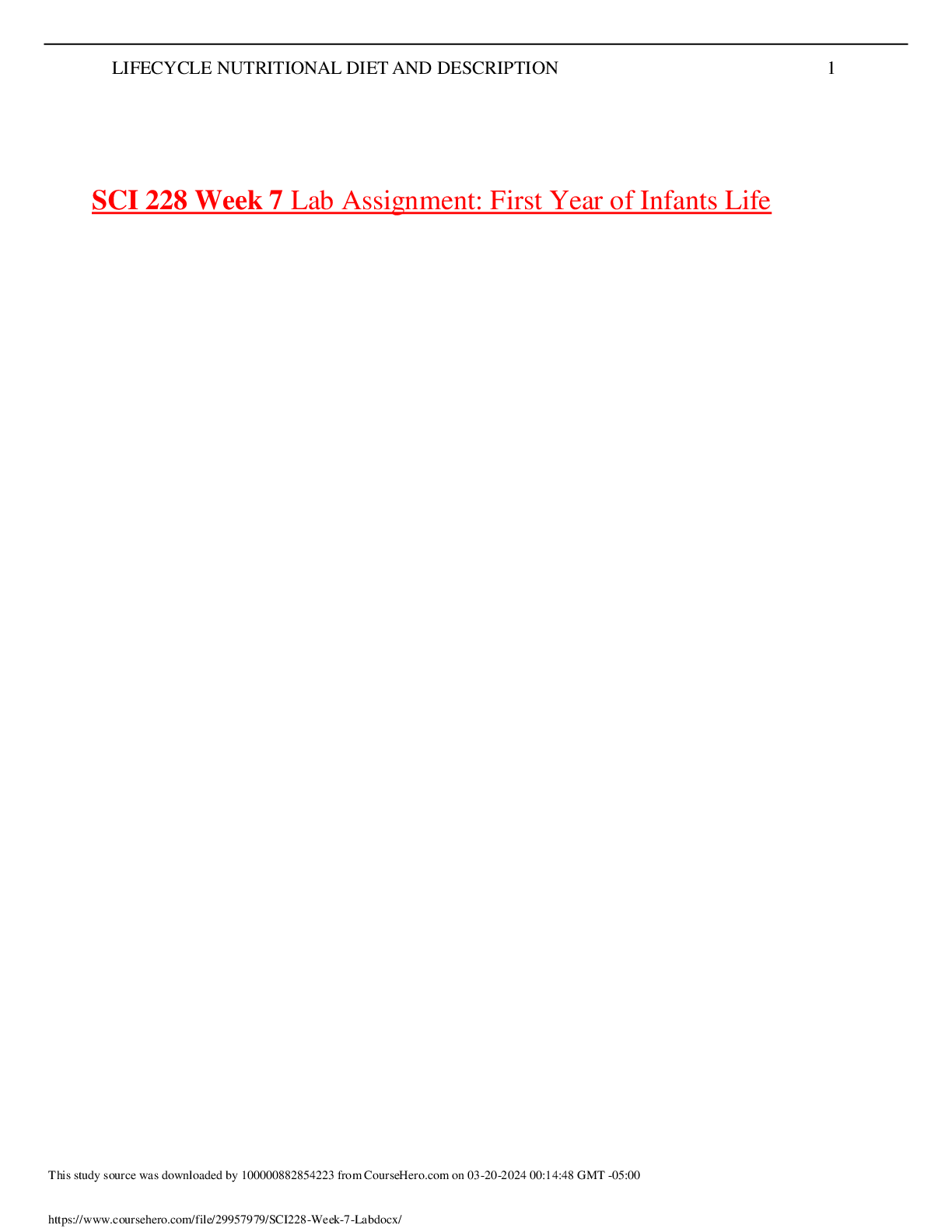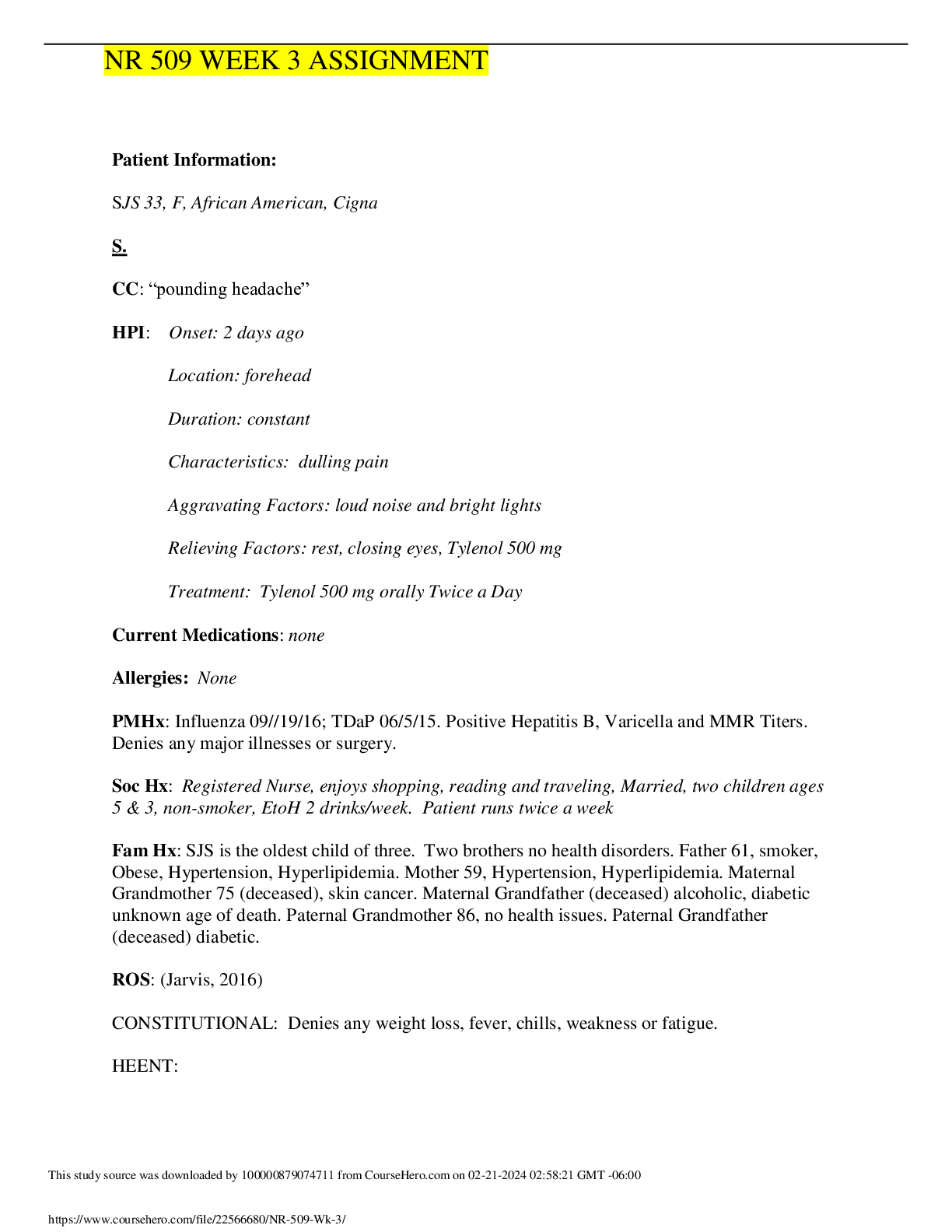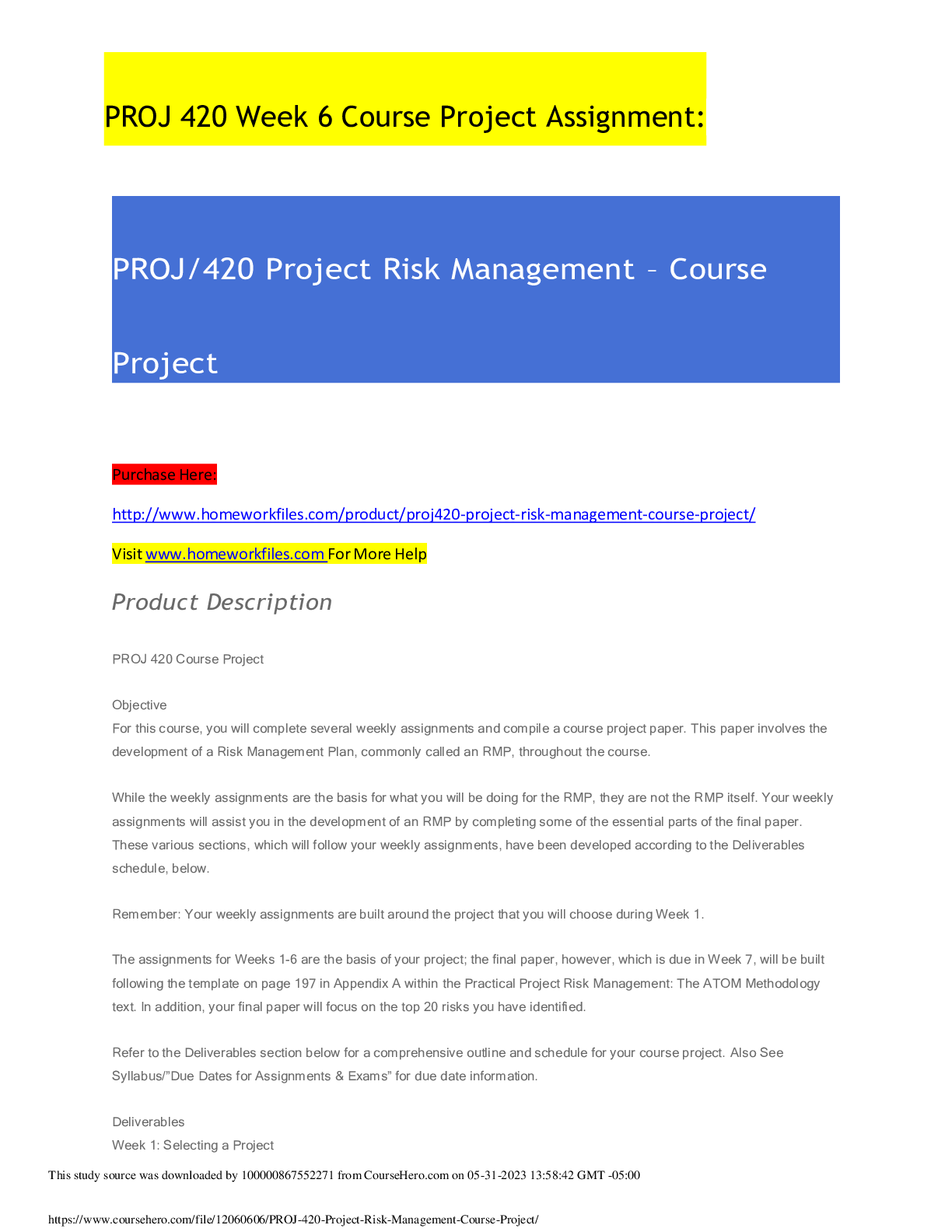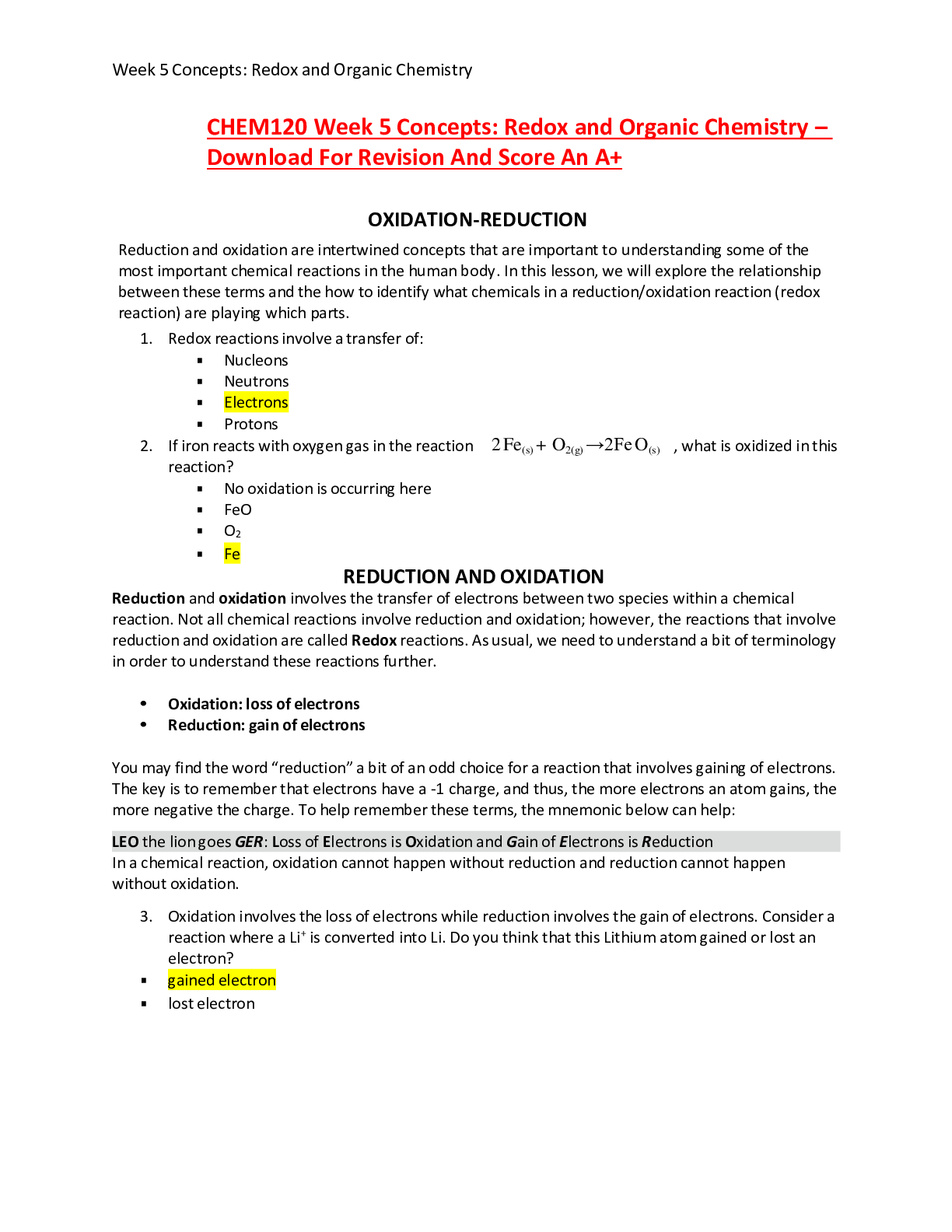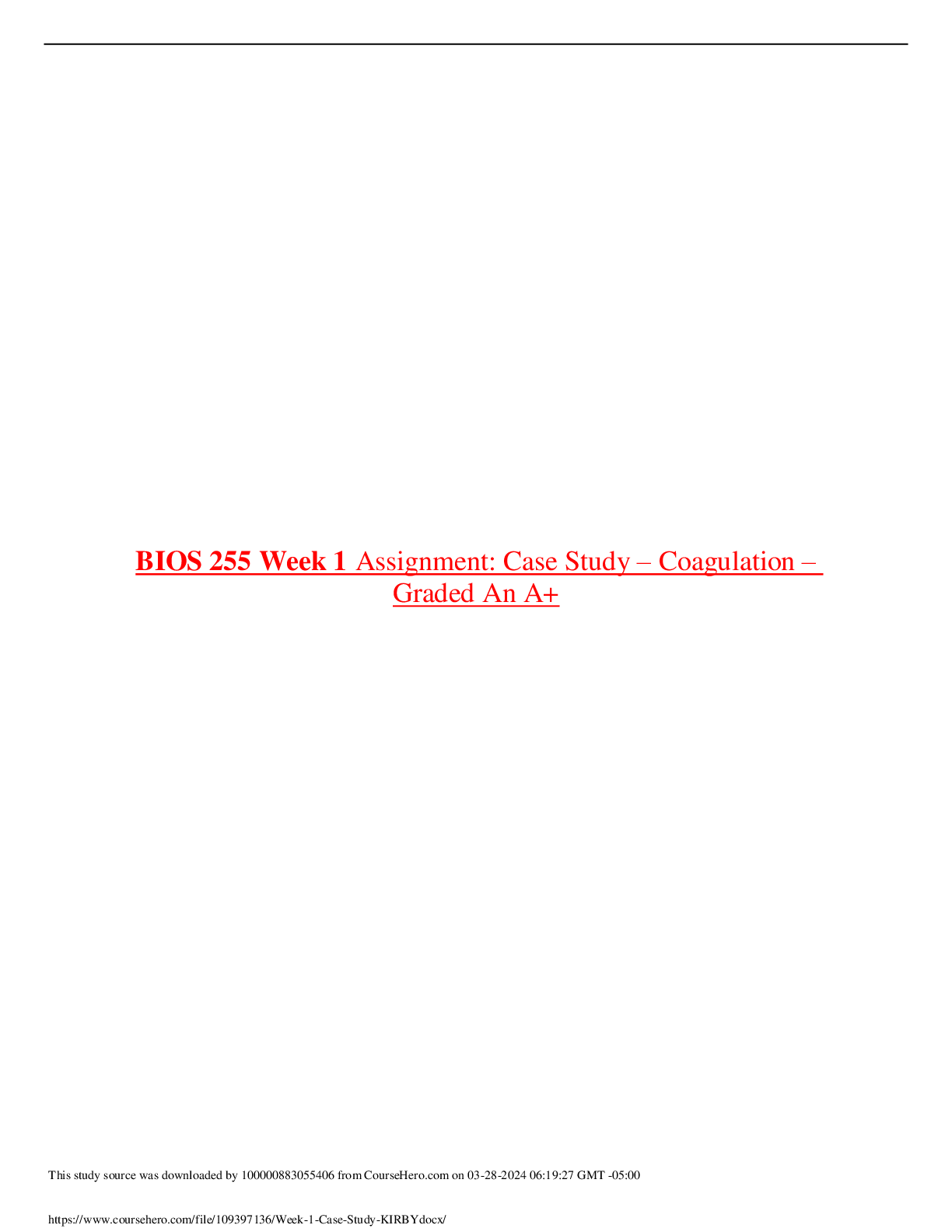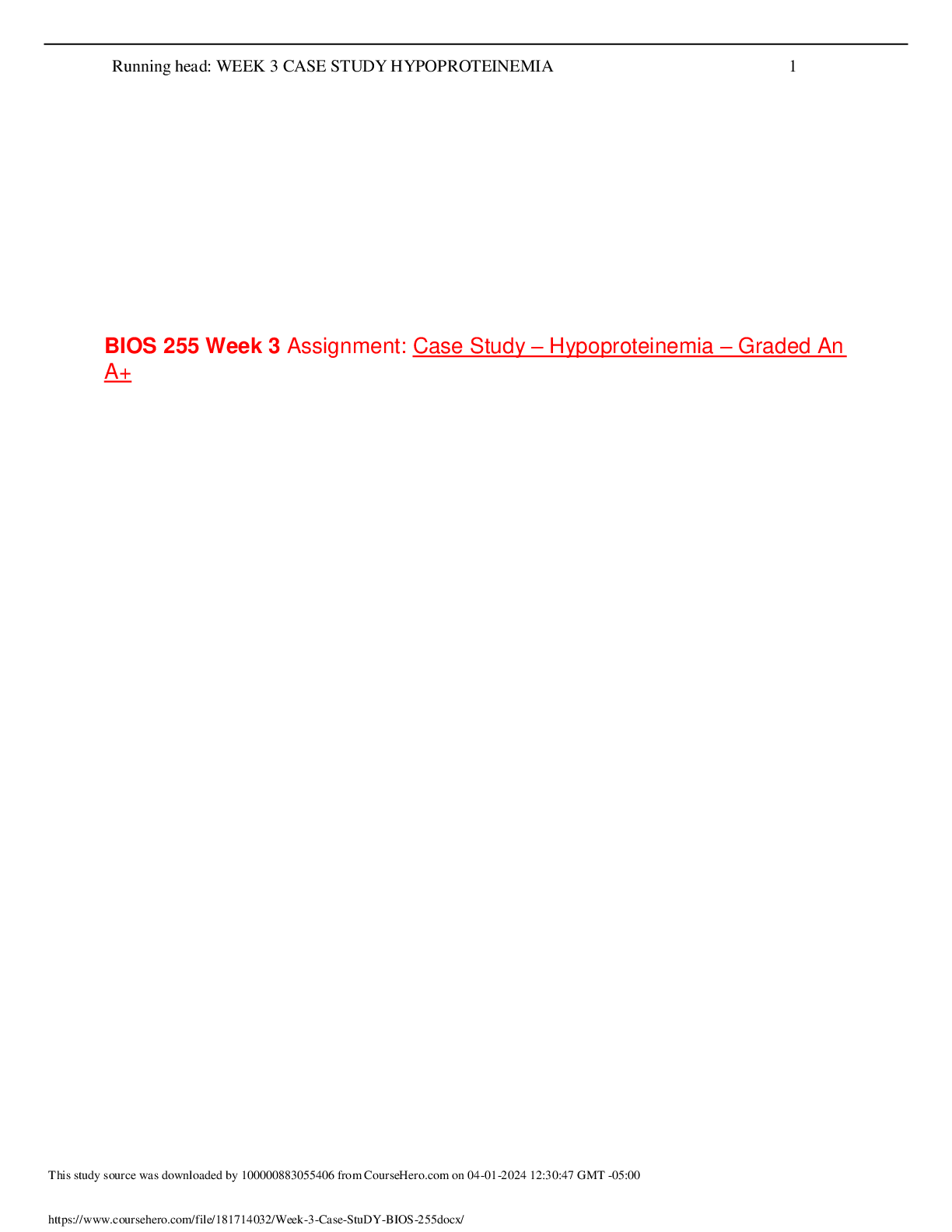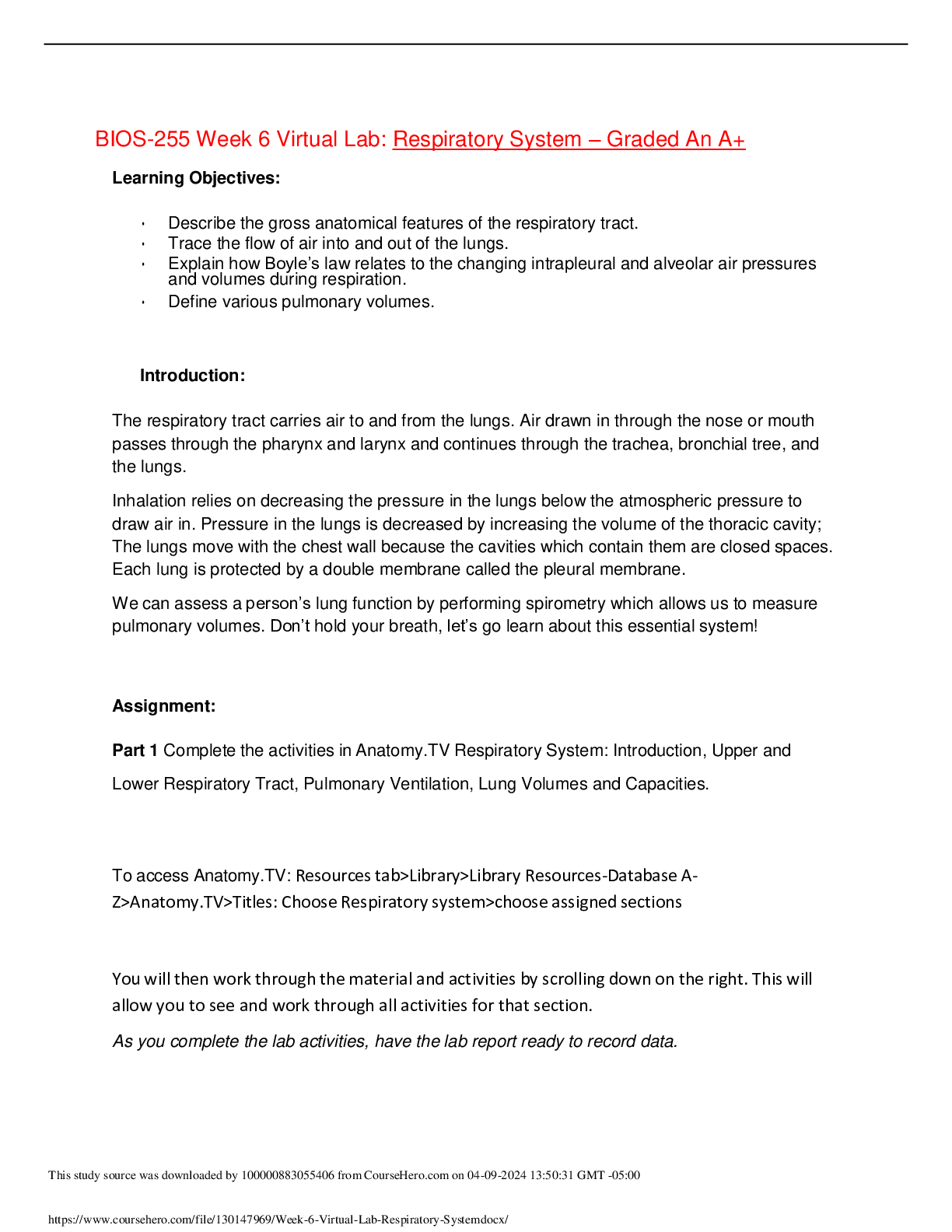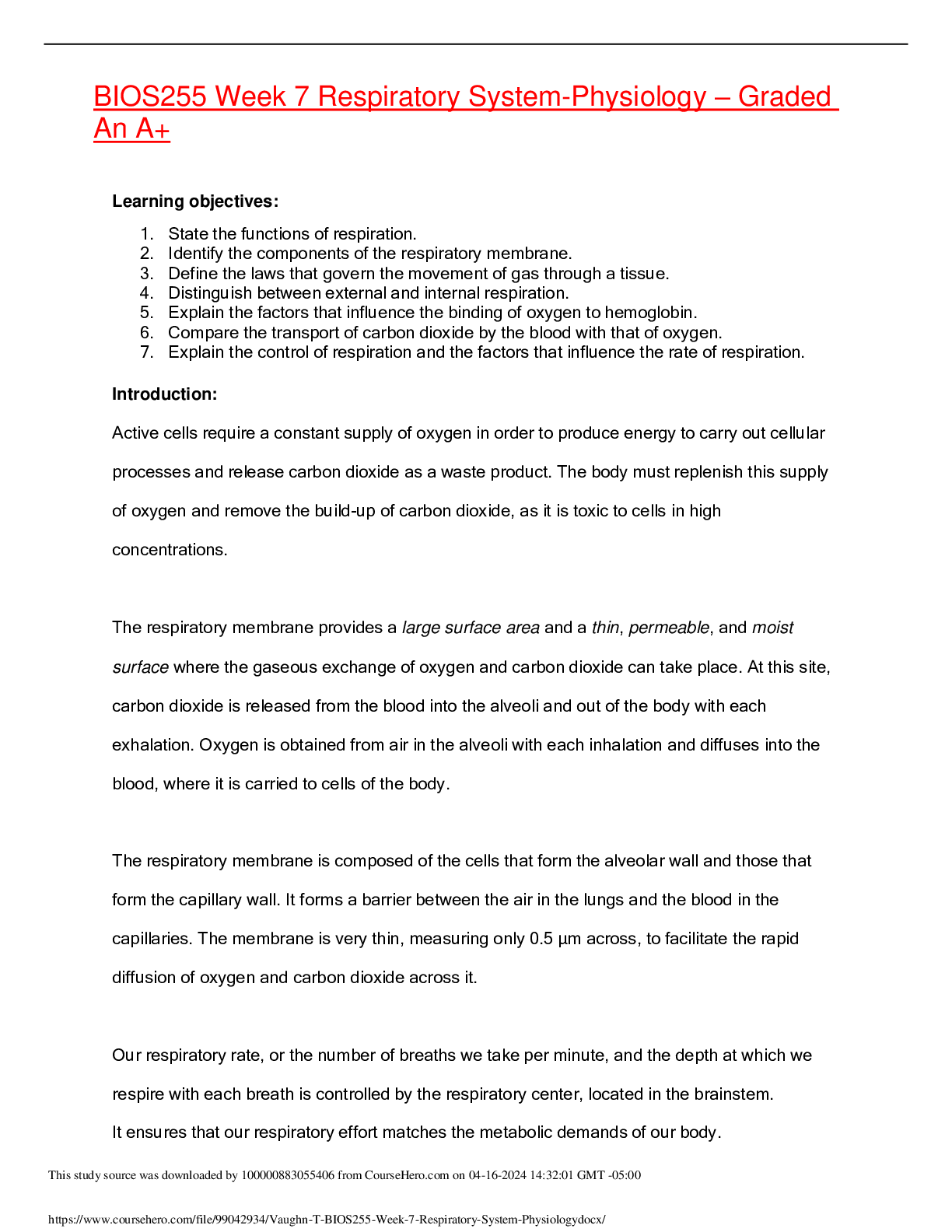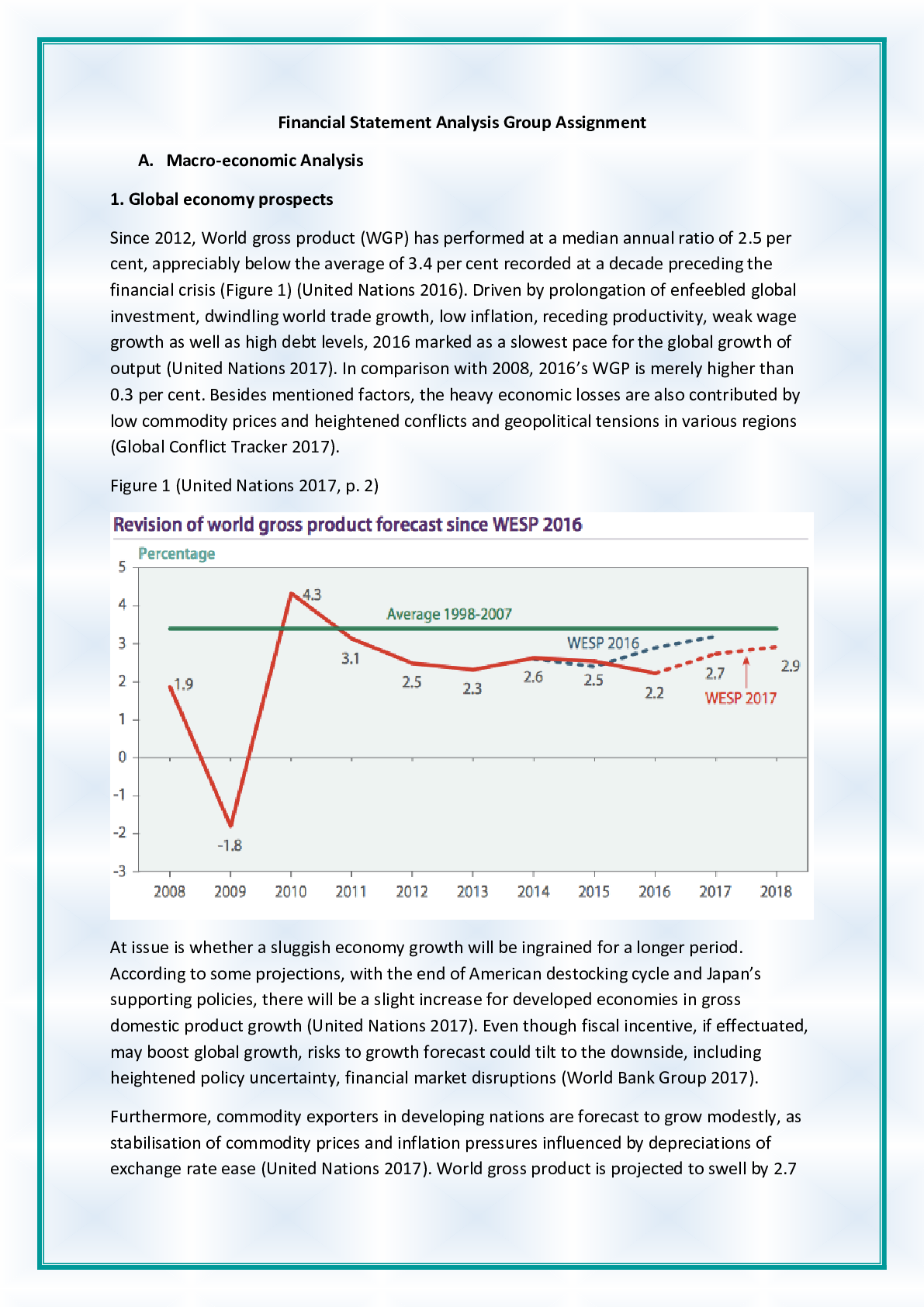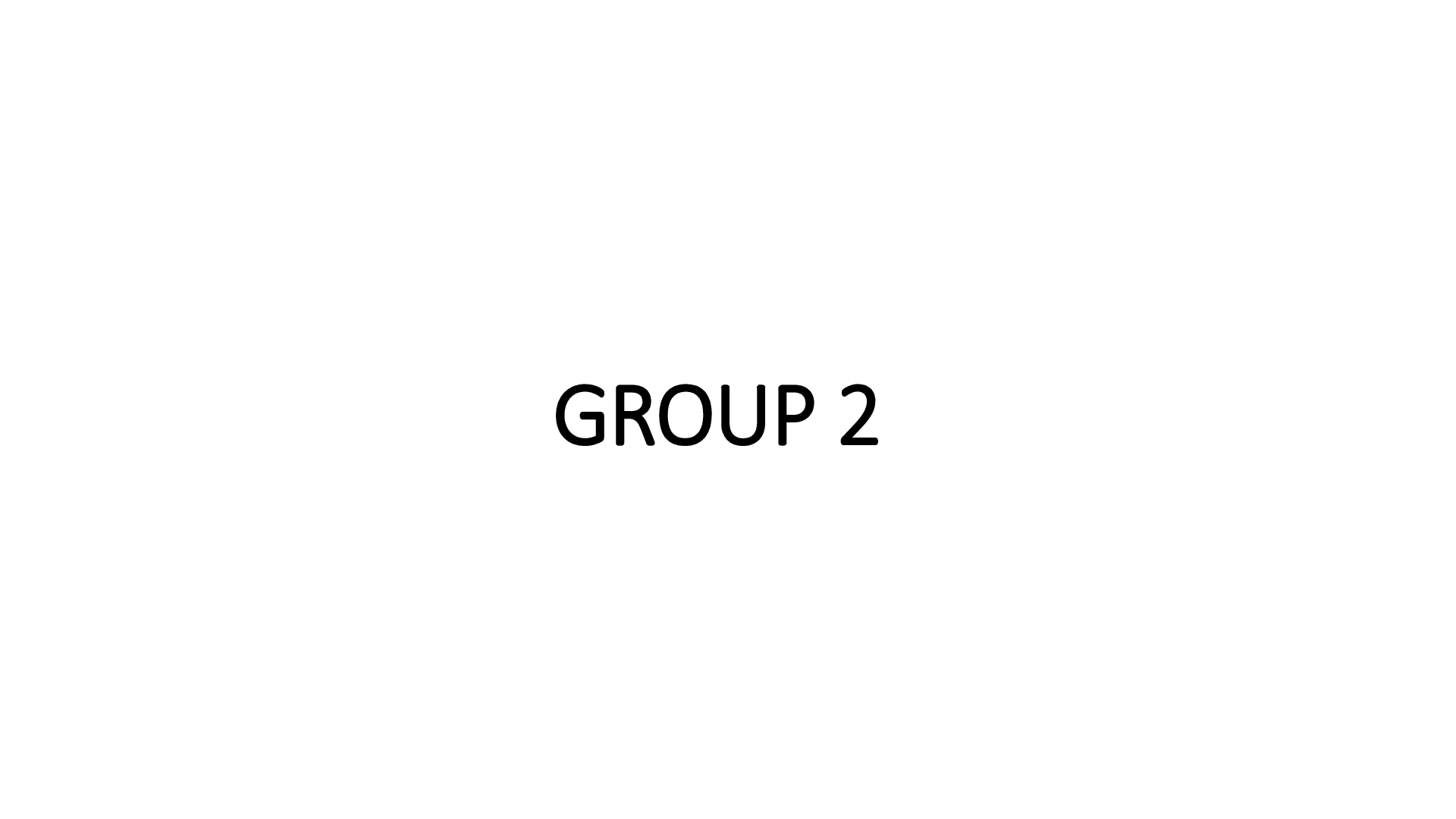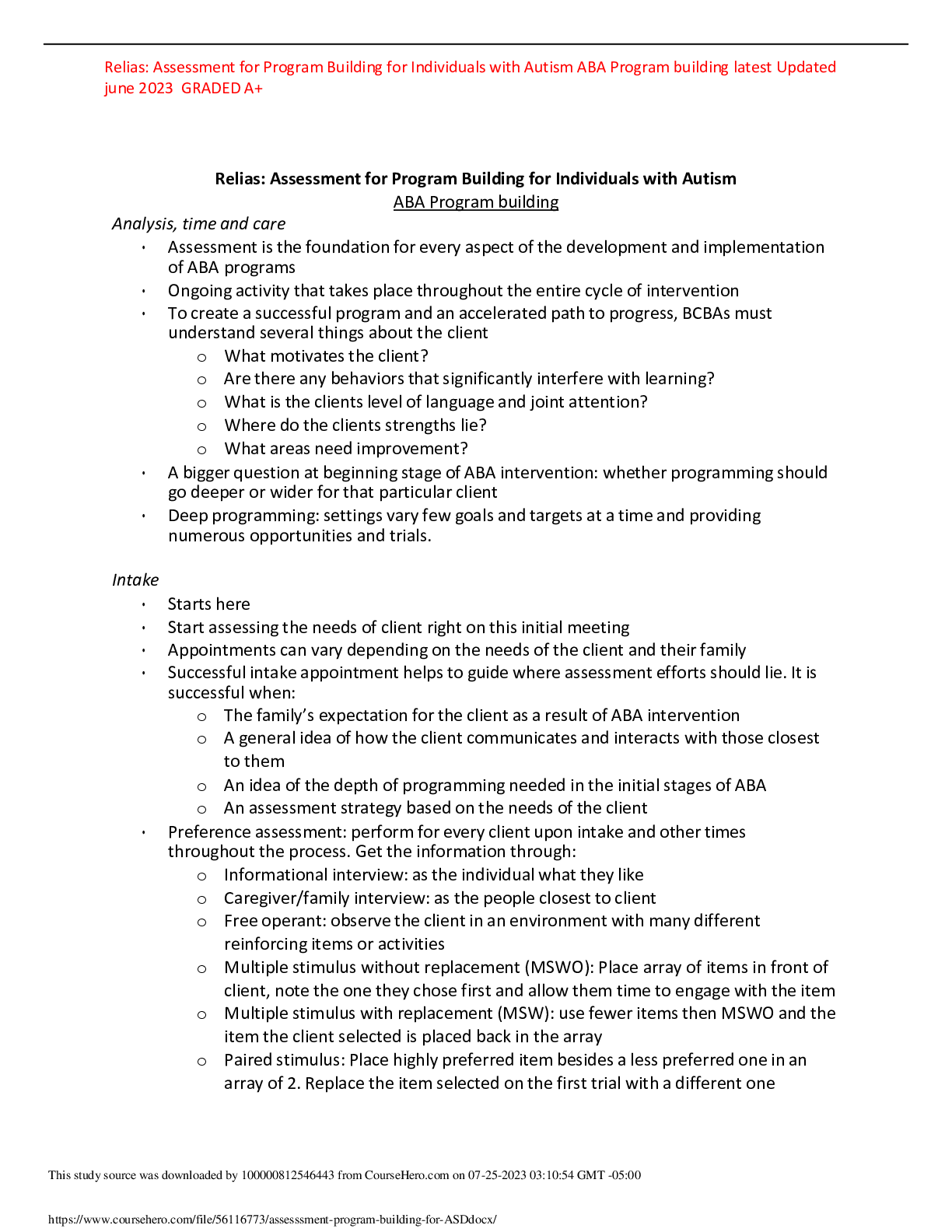*NURSING > ASSIGNMENT > NR 509 – WHEN PERFORMING A PHYSICAL ASSESSMENT – GRADED AN A+ (All)
NR 509 – WHEN PERFORMING A PHYSICAL ASSESSMENT – GRADED AN A+
Document Content and Description Below
NR 509 – WHEN PERFORMING A PHYSICAL ASSESSMENT – GRADED AN A+ When performing a physical assessment, the first technique the nurse will always use B. Inspection The nurse is preparing to ... perform a physical assessment. Which statement is true about the physical assessment? The inspection phase: B. Takes time and reveals a surprising amount of information The nurse is assessing a patient's skin during an office visit. What part of the hand and technique should be used to best assess the patient's skin temperature? B. Dorsal surface of the hand; the skin is thinner on this surface than on the palms Which of these techniques uses the sense of touch to assess texture, temperature, moisture, and swelling when the nurse is assessing a patient? A. Palpation The nurse is preparing to assess a patient's abdomen by palpation. How should the nurse proceed? D. The assessment begins with light palpation to detect surface characteristics and to accustom the patient to being touched. The nurse would use bimanual palpation technique in which situation? B. Palpating the kidneys and the uterus The nurse is preparing to percuss the abdomen of a patient. The purpose of the percussion is to assess the of the underlying tissue. C. Density The nurse is reviewing percussion techniques with a newly graduated nurse. Which technique, if used by the new nurse, indicates that more review is needed? A. Percussing once over each area When percussing over the liver of a patient, the nurse notices a dull sound. The nurse should: A. Consider this a normal finding The nurse is unable to identify any changes in sound when percussing over the abdomen of an obese patient. What should the nurse do next? C. Increase the amount of strength used when attempting to percuss over the abdomen The nurse hears bilateral loud, long and low tones when percussing over the lungs of a 4 year old child. The nurse should D. Consider this finding as normal for a child this age and proceed with the examination A patient has suddenly developed shortness of breath and appears to be insignificant respiratory distress. After calling the position and placing the patient on oxygen, which of these actions is the best for the nurse to take went further assisting this patient? B. Bilaterally percuss the thorax, noting any differences in percussion tones The nurse is teaching a class on basic assessment skills. Which of these statements is true regarding the stethoscope and its use? B. Although the stethoscope does not magnify sound, it does block out extraneous room noise The nurse is preparing to use a stethoscope for auscultation. Which statement is true regarding the diaphragm of the stethoscope? The diaphragm: A. Is used to listen for high-pitched sounds Before auscultating the abdomen for the presence of bowel sounds on a patient, the nurse should: D. Check the temperature of the room and offer blankets to the patient if she or he feels cold. The nurse will use which technique of assessment to determine the presence of crepitus, swelling and pulsations? A. Palpation The nurse is preparing to use an otoscope for an examination. Which statement is true regarding the otoscope? The otoscope: D. Directs light into the ear canal and onto the tympanic membrane An examiner is using an ophthalmoscope to examine a patient's eyes. The patient has astigmatism and is nearsighted. The use of which of these techniques would indicate that the examination is being correctly performed? D. Rotating the lens selector dial to bring the object into focus The nurse is unable to palpate the right radial pulse on a patient. The best action would be to: C. Use a Doppler device to check for pulsations over the area The nurse is preparing to perform a physical assessment. The correct action by the nurse is reflected by which statement? The nurse: D. Organizes the assessment to ensure that the patient does not change positions too often A man is at the clinic for a physical examination. He states that he is very anxious about the physical examination. What steps can the nurse take to make him more comfortable? A. Appear unhurried and confident when examining him When performing a physical examination, safety must be considered to protect the examiner in the patient against the spread of the infection. Which of these statements describes the most appropriate action the nurse should take when performing a physical examination ? B. Hands are washed before and after every physical patient encounter The nurses examining a patient lower leg and notices a training ulceration. Which of these actions is most appropriate in this situation? C. Washing hands, putting on gloves, and continuing with the examination of the ulceration During the examination offering some brief teaching about the patient's body or examiners finding is often appropriate. Which one of these statements by the nurse is most appropriate? C. Your pulse is 80 beats per minute which is within the normal range The nurse keeps in mind that the most important reason to share information and to offer brief teaching while performing be physical examination is to help the: B. Examiner to build rapport and to increase patient's confidence in him or her The nurses examining an infant and prepares to elicit the Moro reflex at which time during the examination? B. At the end of the examination When preparing to perform a physical examination of the infant, the nurse should: A. Have the parent remove all clothing except the diaper on a boy. A 6-month-old infant has been brought to the well child clinic for a checkup. she is currently sleeping. What should the nurse do first when beginning the examination? A. Auscultate the lungs and heart while the infant is sleeping A 2-year-old child has been brought to the clinic for a well child checkup. the best way for the nurse to begin the assessment is to: C. Allow the child to keep a security object such as a toy or blanket during the examination The nurses examining a 2-year-old child and asks may I listen to your heart now? Which critique of the nurse's technique is most accurate D. Children at this age like to say no. the examiner should not offer a choice when no choice is available With which of these patients would it be most appropriate for the nurse to use games during the assessment, such as having the patient blow out the light on a pen light? B. Preschool child The nurse is preparing to examine a 4-year-old child. which action is appropriate for this age group? B. Give the child feedback and reassurance during the examination When examining a 16-year-old male teenager, the nurse should: D. Provide feedback that his body is developing normally, and discuss the wide variation among teenagers on the rate of growth and development When examining an older adult, the nurse should use which technique? D. The range the sequence of the examination to allow as few position changes as possible The most important step that the nurse can take to prevent the transmission of microorganisms in the hospital setting is too: C. Wash hands before and after contact with each patient Which of the statements is true regarding the use of standard precautions in the health care setting? C. Standard precautions are intended for use with all patients, regardless of their risk or presumed infection status The nurse is preparing to assess a hospitalized patient who is experiencing significant shortness of breath. How should the nurse proceed with the assessment? D. Body areas appropriate to the problem should be examined and then the assessment completed after the problem has resolved When examining an instant, the nurse should examine which area first? D. Abdomen While auscultating heart sounds, the nurse here is a murmur. Which of these instruments should be used to assess this murmur? B. Bell of the stethoscope During an examination of a patient abdomen, the nurse notes that the abdomen is rounded and firm to the touch period during percussion, the nurse notes a drum like quality of the sounds across the quadrants. this type of sound indicates: B. Air filled areas The nurse is preparing to examine a 6-year-old child. which action is the most appropriate? C. The nurse should keep in mind that a child at this age will have a sense of modesty During auscultation of a patient's heart sounds, the nurse here's an unfamiliar sound. the nurse should: D. Ask another nurse to double check the finding The nurse is preparing to palpate the thorax and abdomen of a patient. which of these statements describes the correct technique for this procedure? select all that apply A. Warm the hands before touching be patient B. For deep palpation, use one long continuous palpation when assessing the liver C. Start with light palpation to detect surface characteristics D. Use the fingertip to examine skin texture, swelling, pulsation, and presence of lumps E. Identify any tender areas and palpate them last F. Use the palms of the hands to assess temperature of the skin Answer A,C,D,E The nurse is performing a general survey period which action is a component of the general survey? A. Observing the patient's body stature and nutritional status When measuring a patients wait, the nurse is aware of which of these guidelines? D. In temp should be made to weigh the patient at approximately the same time of day, if a sequence of weight is necessary A patient's weekly blood pressure readings for 2 months have ranged between 124/84 mmHg and 138/88 mmHg, with an average reading of 126/86 mmHg. The nurse knows that this blood pressure falls within which blood pressure category? B. Prehypertension During an examination of a child, the nurse considers that physical growth is the best index of a child's : A. general Health A one-month old infant has a head measurement of 34 centimeters and has a chest circumference of 32 centimeters. Based on the interpretation of these findings, the nurse would: B. Consider these findings normal for a one-month old infant The nurse is assessing and 80-year-old male patient. which assessment findings would be considered normal? C. Presence of kyphosis and flexion in the knees and hips The nurse should measure rectal temperatures in which of these patients? C. Comatose adult The nurse is preparing to measure the length, wait, just, and head circumference of a 6 month old infant. Which measurement technique is correct? C. Measuring the chest circumference at the nipple line with a tape measure The nurse knows that one advantage of the tympanic membrane thermometer is that: A. Rapid measurement is useful for uncooperative young children When assessing an older adult, which vital signs changes occur with aging? B. Widened pulse pressure The nurses examining a patient who is complaining of feeling cold. Which is a mechanism of heat loss in the body? B. Radiation When measuring a patient's body temperature, the nurse keeps in mind that the body temperature is influenced by : C. Diurnal cycle When evaluating the temperature of older adults, the nurse should remember which aspect about an older adult's body temperature? A. The body temperature of the older adult is lower than that is a younger adult A 60-year-old male patient has been treated for pneumonia for the past 6 weeks. he is seen today in the clinic for an unexplained weight loss of 10 pounds over the last 6 weeks. the nurse knows that: C. Unexplained weight loss often accompanies short term illnesses When assessing a 75 year old patient who has asthma, the nurse notes that he assumes a tripod position, leaning forward with arms braced on the chair. on the basis of this observation, the nurse should: D. Recognize that a tripod position is often used when a patient is having respiratory difficulties which of these actions illustrates the correct technique the nurse should use when assessing oral temperature with a mercury thermometer? B. Leave the thermometer in place for 3 to 4 minutes if the patient is afebrile The nurse is taking temperatures in a clinic with a TMT. Which statement is true regarding the use of the TMT? C. The risk of cross-contamination is reduced, compared to the rectal route To assess a rectal temperature accurately in an adult, the nurse would: A. Use a lubricated blunt tip thermometer Which technique is correct when the nurse is assessing the radial pulse of a patient? The post is counted for: A. One minute if the rhythm is irregular When assessing a patient's pulse comment the nurse should also notice which of these characteristics? A. Force When assessing the pulse of a 6-year-old boy, the nurse notices that his heart rate varies with his respiratory cycle, speeding up at the peak of inspiration and slowing to normal with expiration. the nurses next action would be to: B. Consider this finding normal in children and young adults When assessing the force, or strength, of a pulse, the nurse recalls that the pulse: C. Is a reflection of the hearts stroke volume The nurse is assessing the vital signs of a 20-year-old male marathon runner and documents the following vital signs: temperature 36 C, pulse 48 beats per minute, respirations 14 breaths per minute, blood pressure 104/68. Which statement is true concerning these results? B. These are normal vital signs for a healthy, athletic adult The nurse is assessing the vital signs of a 3-year-old patient who appears to have an irregular respiratory pattern how should the nurse assess this child respirations? A. Respiration should be counted for one full minute, noticing the rate and rhythm A patient's blood pressure is 118/82 mmHg. He asks the nurse what do the numbers mean? The nurse's best reply is: C. The top number is the systolic blood pressure and reflects the pressure of the blood against the arteries when the heart contracts While measuring a patient's blood pressure, the nurse recalls that certain factors, such as , help determine blood pressure. D. Peripheral vascular resistance A nurse is helping at a health fair at a local mall. when taking blood pressures on a variety of people, the nurse keeps in mind that: B. The blood pressure of a black adult is usually higher than that of a white adult of the same age The nurse notices a colleague is preparing to check the blood pressure of a patient who is obese by using a standard sized blood pressure cuff. The nurse should expect the reading to: B. Yield a falsely high blood pressure A student is late for his appointment and has rushed across campus to the health clinic. the nurse should: A. Allow 5 minutes for him to relax and rest before checking his vital signs The nurse will perform a palpated pressure before auscultating blood pressure. The reason for this is to: B. Detect the presence of an auscultatory gap The nurse is taking an initial blood pressure reading on 72-year-old patient with documented hypertension. How should the nurse proceed? C. Cuff should be inflated 30 mm Hg above the point at which the palpated pulse disappears The nurse has collected the following information on a patient; palpated blood pressure 180 mm Hg, auscultated blood pressure 170/100 mmHg, apical pulse 60 bpm, radial pulse 70bpm. What is the patients pulse pressure? B. 70 When auscultating the blood pressure of a 25 year old patient, the nurse notices the phase I Korotkoff sounds begin a 200mmHg. At 100mm Hg the Korotkoff sounds muffle. At 92mmHg the Korotkoff sounds disappear. How should the nurse record this patients blood pressure? A. 200/92 A patient is seen them in clinic for complaints of painting episodes that started last week period How should the nurse proceed with the examination? C. His blood pressure is recorded in the lying, sitting, and standing positions What is the pulse pressure for a patient whose blood pressure is 158/96 mmHg and whose pulse rate is 72 bpm? Answer 62 A 70 year old man has a blood pressure of 150/90 in a lying position, 130/80 in a sitting position, and 100/60 in a standing position. How should the nurse evaluate these findings? B. The change in blood pressure readings is called orthostatic hypotension The nurse is helping another nurse take a blood pressure reading on a patients thigh. Which action is correct regarding the thigh pressure ? C. If the blood pressure is high in an adolescent, then it should be compared with the thigh pressure The nurse is preparing to measure the vital signs of a 6 month old infant. which action by the nurse is correct? A. Respirations are measured, then pulse and temperature A 4-month-old child is at the clinic for a well-baby checkup and immunizations. which of these actions is most appropriate when a nurse is assessing the infant's vital signs? B. The nurse said auscultate and a pickle rate for one minute and then assess for any normal irregularities such as sinus arrhythmia The nurse is conducting a health fair for older adults. which statement is true regarding vital sign measurements in aging adults? B. An increased respiratory rate and shallower inspiratory phase are expected findings In a patient with acromegaly, the nurse will expect to discover which assessment findings? C. Overgrowth of bone in the face, head, hands and feet The nurse is performing a general survey of a patient. Which finding is considered normal? D. Arm span (fingertip to fingertip) equals the patients height The nurse is assessing pediatric children in a pediatric clinic. Which statement is true regarding the measurement of blood pressure in children? D. The disappearance of phase V Korotkoff sounds can be used for the diastolic reading in children What type of blood pressure measurement error is most likely to occur if the nurse does not check for the presence of an auscultatory gap? C. Systolic blood pressure may be falsely low When considering the concepts related to blood pressure, the nurse knows that the concept of mean arterial pressure is best described as which statemen? C. MAP is the pressure forcing blood into the tissues, averaged over the cardiac cycle A 75-year-old man with a history of hypertension was recently changed to a new antihypertensive drug. He reports feeling dizzy at times. How should the nurse evaluate his blood pressure? A. Blood pressure and pulse should be recorded in the supine, sitting and standing positions Which of these specific measurements is the best index of a child's general health? B. Height and weight The nurse is assessing an 8-year-old child whose growth rate measures below the third percentile for a child his age. He appears significantly younger than his stated age and is chubby with infantile facial features. Which condition does this child have? A. Hypopituitary dwarfism The nurse is counting an infant's respirations. Which technique is correct? B. Watching the abdomen for movement When checking for the proper blood pressure cuff size, which guideline is correct? D. The width of the rubber bladder should equal 40% of the arm circumference During an examination a nurse notices that a female patient has a round moon face, central trunk obesity and a cervical hump. Her skin is fragile with bruises. The nurse determines that the patient has which condition? C. Cushing syndrome While measuring a patient's blood pressure, the nurse uses proper technique to obtain an accurate reading. Which of these situations will result in a falsely high blood pressure reading? Select all that apply A. The person supports his or her own arm during the blood pressure reading B. The blood pressure cuff is too narrow for the extremity C. The arm is held above the level of the heart D. The cuff is loosely wrapped around the arm E. The person is sitting with his or her legs crossed F. The nurse does not inflate the cuff high enough Answer A, B, D, E The nurse is testing a patient's visual accommodation, which refers to which action ? D. Constriction of both pupils occurs in response to bright light A position tells the nurse that a patients vertebra prominens is tender and ask the nurse to reevaluate the area in one hour period the area of the body the nurse will assess is: C. At the level of the C 7 vertebra Another brings her 2-month-old daughter in for an examination and says my daughter rolled over against the wall, and now I have noticed that she has the spot that is soft on top of her head. Is something terribly wrong? the nurse's best response would be: D. That soft spot is normal, and actually allows for growth of the brain during the first your of your baby's life.* The nurse notices that a patient's palpebral fissures are not symmetric. On examination, the nurse may find that damage has occurred to which cranial nerve? C. VII A patient is unable to differentiate between sharp and dull stimulation to both sides of her face. The nurse suspects: C. Parotid, submandibular When examining the face of patient, the nurse is aware that the two pairs of salivary glands that are accessible to the examination are the and glands. C. Parotid, submandibular A patient comes to the clinic complaining of neck and shoulder pain and is unable to turn her head. The nurse suspects damage to CN and proceeds with the examination by . B. XI, asking the patient to shrug her shoulders against resistance When examining a patients CN function, the nurse remembers that the muscles in the neck that are innervated by CN XI are the A. Sternomastoid and trapezius A patient's laboratory data reveal an elevated t4 level. The nurse would proceed with an examination of the gland. A. Thyroid A patient says that she has recently noticed a lump in the front of her neck below her Adam's apple that seems to be getting bigger. During the assessment, the finding that leads the nurse to suspect that this may not be a cancerous thyroid nodule is that the lump: B. Is mobile and not hard The nurse notices that patients submental lymph nodes are enlarged. In an effort to identify the cause of the node enlargement, the nurse would assess the patients D. Area proximal to the enlarged node The nurse is aware that the four area in the body where lymph nodes are accessible are the: D. Head and neck, arms, inguinal area, and axillae A mother brings her new born in for an assessment and asks, is there something wrong with my baby? His head seems so big. which statement is true regarding the relative proportions of the head and trunk of the newborn? B. Head circumference should be greater than chest circumference at birth A patient, an 85-year-old woman, is complaining about the fact that her bones in her face have become more noticeable. what explanation should the nurse give her? C. More noticeable facial bones are probably due to a combination of factors related to aging, such as it decreased elasticity, subcutaneous fat, and moisture in the skin A patient reports an excruciating headache pain on one side of his head, especially around his eyes, forehead, and cheek that has lasted Approximately 2 hours, occurring once or twice each day period the nurse should suspect: B. Cluster headaches A patient complains that while studying for an examination he began to notice a severe headache and they frontotemporal Area of his head that is throbbing and a somewhat relieved when he lies down. he tells the nurse that his mother also has these headaches. The nurse suspects that he may be suffering from: D. Migraine headaches A 19-year-old college student is brought to the emergency Department with a severe headache he describes as like nothing I've ever had before. His temperature is 40 C And he has a stiff neck. The nurse looks for other signs and symptoms of which problem? D. Meningeal inflammation During a well-baby checkup, the nurse notices that a one-week old infant's face looks small compared with his cranium, which seems enlarged. On further examination, the nurse also notices dilated scalp veins and down cast or setting sun eyes. The nurse suspects which condition? C. Hydrocephalus The nurse needs to palpate the temporomandibular joint for crepitation. This joint is located just below the temporal artery and anterior to the: C. Tragus A patient has come in for an examination and states, I have the spot in front of my earlobe on my cheek that seems to be getting bigger and is tender. What do you think it is? The nurse notes swelling below the angle of the jaw and suspects that it could be an inflammation of his: B. Parotid gland A male patient with a history of AIDS has come in for an examination and he states, I think I have the mumps. The nurse would begin by examining the: B. Parotid gland The nurse suspects that a patient has hyperthyroidism, in the laboratory data indicate that the patients T 4 and T 3 hormone levels or elevated. which of these findings with the nurse most likely find an examination? A. Tachycardia A visitor from Poland who does not speak English seems to be somewhat apprehensive about the nurse examining his neck. he would probably be more comfortable with the nurse examining his thyroid gland from: C. The front with the nurse's thumbs placed on either side of his trachea in his head tilted forward A patient's thyroid gland is enlarged, and the nurse is preparing to auscultate the thyroid gland for the presence of a bruit. A bruit is a sound that is heard best with the of the stethoscope. C. Soft wooshing, pulsatile, bell The nurse notices that an infant has a large, soft lump on the side of his head and that his mother is very concerned. she states that she noticed the lump approximately 8 hours after her baby's birth and that it has seem to get bigger. One possible e xplanation for this is C. Cephalhematoma A mother brings in her newborn infant for an assessment and tells the nurse that she has notice that whenever her newborn's head is turned to the right side she straightens out the arm and leg on the same side and flex is the opposite arm and leg. After observing this an examination call it the nurse tells her that this reflex is: A. Abnormal and is called the atonic neck reflex B. Normal and should disappear by the first year of life C. Normal and is called the tonic neck reflex, which should disappear between 3 and 4 months of age D. Abnormal. The baby should be flexing the arm and leg on the right side of his body when the head is turned to the right. C. Normal and is called the tonic neck reflex, which should disappear between 3 and 4 months of age During an admission assessment, the nurse notices that a male patient has an enlarged and rather thick skull. The nurse suspects acromegaly and would further assess for: A. Exophthalmus B. Bowed long bones C. Coarse facial features D. Acorn-shaped cranium C. Coarse facial features When examining children affected with Down syndrome (trisomy 21) the nurse looks for the possible presence of A. Ear dysplasia B. Long, thin neck C. Protruding thin tongue D. Narrow and raised nasal bridge A. Ear dysplasia A patient this is the clinic because he has recently noted that the left side of his mouth is paralyzed. he states that he cannot raise his eyebrow or whistle. the nurse suspects that he has: A. Cushing syndrome B. Parkinson disease C. Bell palsy D. Experienced a CVA or stroke C. Bell palsy A woman comes to the clinic and states, I've been sick for so long! My eyes have gotten so puffy and my eyebrows and hair have become course and drive. the nurse will assist for other signs and symptoms of: A. Cachexia B. Parkinson Syndrome C. Myxedema D. Scleroderma C. Myxedema During an examination of a female patient, the nurse notes lymphadenopathy and suspects and acute infection. Acutely infected lymph nodes would be: A. Clumped B. Unilateral C. Firm by freely moveable D. Firm and nontender C. Firm by freely moveable The physician reports that a patient with a neck tumor has a tracheal shift. The nurse is aware that this means that the patient's trachea is: A. Pulled to the affected side B. Pushed to the unaffected side C. Pulled downward D. Pulled downward in a rhythmic pattern B. Pushed to the unaffected side During an assessment of an infant, the nurse notes that the fontanels are depressed and sunken. The nurse suspects which condition? A. Rickets B. Dehydration C. Mental retardation D. Increased intracranial pressure B. Dehydration The nurse is performing an assessment on a 7-year-old child who has symptoms of chronic watery eyes, sneezing, and clear nasal drainage. The nurse notices the presence of a transverse line across the bridge of the nose, dark blue shadows below the eyes, and a double crease on the lower eyelids. these findings are characteristic of: A. Allergies B. Sinus infection C. Nasal congestion D. Upper respiratory infection A. Allergies While performing a well child assessment on a 5-year-old, the nurse notes the presence of palpable, bilateral, cervical, and inguinal lymph nodes. They are approximately 0.5 centimeters in size, round, mobile, and nontender. The nurse suspects that this child: A. Has chronic allergies B. May have an infection C. Is exhibiting a normal finding for a well child of this age D. Should be referred for additional evaluation C. Is exhibiting a normal finding for a well child of this age The nurse has just completed a lymph node assessment on a 60-year-old healthy female patient. The nurse knows that most lymph nodes and healthy adults are normally: A. Shotty B. Nonpalpable C. Large, firm, and fixed to the tissue D. Rubbery, discrete and mobile B. Nonpalpable During an examination of a patient in her third trimester of pregnancy, the nurse notices that the patient's thyroid gland is slightly enlarged. No enlargement had been previously noticed. The nurse suspects that the patient: A. Has an iodine deficiency B. Is exhibiting early signs of goiter C. Is exhibiting a normal enlargement of the thyroid gland during pregnancy D. Needs further testing for possible thyroid cancer C. Is exhibiting a normal enlargement of the thyroid gland during pregnancy During an examination, the nurse knows that the best way to palpate the lymph nodes in the neck to described by which statement? A. Using gentle pressure, palpate with both hands to compare the two sides B. Using strong pressure, palpate with both hands to compare the two sides C. Gently pinch each node between one's thumb and forefinger, and then move down the neck muscle D. Using the index and middle fingers, gently palpate by applying pressure in a rotating pattern A. Using gentle pressure, palpate with both hands to compare the two sides During a well-baby checkup, a mother is concerned because her 2-month-old infant cannot hold her head up when she is pulled to a sitting position. which response by the nurse is appropriate? A. Head control is usually achieved by 4 months of age B. You shouldn't be trying to pull your baby up like that until she is older C. Head control should be achieved by this time D. This inability indicates possible nerve damage to the neck muscles A. Head control is usually achieved by 4 months of age During an examination of a 3-year-old child, the nurse notices a bruit Over the left temporal area. the nurse should: A. Continue the examination because a bruit is a normal finding for this age B. Check for the bruit again in 1 hour C. Notify the parents that a bruit has been detected in their child D. Stop the examination and notify the physician A. Continue the examination because a bruit is a normal finding for this age During an examination, the nurse palpates a patients left temporal artery is tortuous and feels hard and tender, compared with the right temporal artery. The nurse suspects which condition? A. Crepitation B. Mastoiditis C. Temporal arteritis D. Bell palsy C. Temporal arteritis The nurse is assessing a one-month old infant at his well-baby checkup. which assessment findings are appropriate for this age? Select all that apply A. Head circumference equal to chest circumference B. Head circumference greater than chest circumference C. Head circumference less than chest circumference D. Fontanels firm and slightly concave E. Absent tonic neck reflex F. Non-palpable cervical lymph nodes Answer B,D,F When examining the eye, the nurse notices that the patient's eyelid margins approximate completely. The nurse recognizes that this assessment finding: A. Is expected B. May indicate a problem with extraocular muscles C. May result in problems with tearing D. Indicates increased intraocular pressure A. Is expected During the ocular examinations, the nurse keeps in mind that movement of the extra ocular muscles is: A. Decreased in the older adult B. Impaired in a patient with cataracts C. Stimulated by cranial nerves I and II D. Stimulated by CNs II IV and VI D. Stimulated by CNs II IV and VI The nurse is performing an external eye examination. Which statement regarding the outer layer of the eye is true? A. The outer layer of the eye is very sensitive to touch B. The outer layer of the eye is darkly pigmented to prevent light from reflecting internally C. The trigeminal nerve (CN V) and the trochlear nerve (CN IV) are stimulated when the outer surface of the eye is stimulated D. The visual receptive layer of the eye in which light waves are changed into nerve impulses is located in the outer layer of the eye A. The outer layer of the eye is very sensitive to touch When examining a patient's eyes, the nurse recalls that stimulation of the sympathetic branch of the autonomic nervous system: A. Causes pupillary constriction B. Adjust the eye for near vision C. Elevates the eyelid and dilates the pupil D. Causes constriction of the ciliary body C. Elevates the eyelid and dilates the pupil The nurse is reviewing causes of increased intraocular pressure. Which of these factors determines intraocular pressure? A. Thickness or bulging of the lens B. Posterior chamber as it accommodates increased fluid C. Contraction of the ciliary body in response to the aqueous within the eye D. Amount of aqueous produced in resistance to it out flow at the angle of the anterior chamber D. Amount of aqueous produced in resistance to it out flow at the angle of the anterior chamber The nurse is conducting a visual examination. which of the statements regarding visual pathways and visual field is true? A. The right side of the brain interprets vision for the right eye B. The image formed on the retina is upside down in reversed from its actual appearance in the outside world C. Light Rays are refracted through the transparent media of the eye before striking the people D. Light impulses are conducted through the optic nerve to the temporal lobes of the brain B. The image formed on the retina is upside down in reversed from its actual appearance in the outside world A mother asks when her newborn infant's eyesight will be developed. The nurse should reply: A. Vision is not totally developed until 2 years of age B. Infants develop the ability to focus on an object at approximately 8 months of age C. By approximately 3 months of age, infants develop more coordinated eye movements and can fixate on an object D. Most infants have uncoordinated eye movements for the first year of life. C. By approximately 3 months of age, infants develop more coordinated eye movements and can fixate on an object The nurse is reviewing age related changes in the eye for a class. Which of these physiologic changes is responsible for presbyopia? A. Degeneration of the cornea B. Loss of lens elasticity C. Decreased adaptation to darkness D. Decreased distance in vision abilities B. Loss of lens elasticity Which of these assessment findings would the nurse expect to see when examining the eyes of a black patient? A. Increased night vision B. Dark retinal background C. Increased photosensitivity D. Narrowed palpebral fissures B. Dark retinal background A 52-year-old patient describes the presence of occasional floaters or spots moving in front of his eyes. The nurse should A. Examine the retina to determine the number of floaters B. Presume the patient has glaucoma and refer him for further testing C. Consider these to be abnormal findings and refer him to an ophthalmologist D. Know that floaters are usually insignificant and are caused by condensed vitreous fibers D. Know that floaters are usually insignificant and are caused by condensed vitreous fibers The nurse is preparing to assess the visual acuity of a 16-year-old patient. How should the nurse proceed? A. Perform the confrontation test B. Aske the patient to read the print on a handheld Jaeger card C. Use the Snellen chart positioned 20 feet away from the patient D. Determine the patient's ability to read newsprint at a distance of 12 to 14 inches C. Use the Snellen chart positioned 20 feet away from the patient A patient's vision is recorded as 20/30 when the Snellen eye chart is used. The nurse interprets these results to indicate that: A. At 30 feet the patient can read the entire chart B. The patient can read at 20 feet what a person with normal vision can read at 30 feet C. The patient can read the chart from 20 feet in the left eye and 30 feet in the right eye D. The patient can read from 30 feet what a person with normal vision can read at 20 feet B. The patient can read at 20 feet what a person with normal vision can read at 30 feet A patient is unable to read even the largest letters on the Snellen chart. The nurse should take which action next? A. Refer the patient to an ophthalmologist or optometrist for further evaluation B. Assess whether the patient can count the nurse's fingers when they are placed in front of his or her eyes C. Ask the patient to put on his or her reading glasses and attempt to read the Snellen chart again D. Shorten the distance between the patient and the chart until the letters are seen and record that distance D. Shorten the distance between the patient and the chart until the letters are seen and record that distance A patient's vision is recorded as 20/80 in each eye. The nurse interprets this finding to mean that the patient: A. Has poor vision B. Has acute vision C. Has normal vision D. Is presbyopic A. Has poor vision When performing the corneal light reflex assessment, the nurse noted that the light is reflected at 2 o'clock in each eye. The nurse should: A. Consider this a normal finding B. Refer the individual for further evaluation C. Document this finding as an asymmetric light reflex D. Perform the confrontation test to validate the findings A. Consider this a normal finding The nurse is performing the diagnostic positions test. Normal findings would be which of these results? A. Convergence of the eyes B. Parallel movement of both eyes C. Nystagmus in extreme superior gaze D. Slight amount of lid lag when moving the eyes from a superior to an inferior position B. Parallel movement of both eyes During an assessment of the sclera of a black patient, the nurse would consider which of these an expected finding? A. Yellow fatty deposits over the cornea B. Pallor near the outer canthus of the lower lid C. Yellow color of the sclera that extends up to the iris D. Presence of small brown macules on the sclera D. Presence of small brown macules on the sclera A 60-year-old man is at the clinic for an eye examination. The nurse suspects that he has ptosis of one eye. How should the nurse check for this? A. Perform the confrontation test B. Assess the individuals near vision C. Observe the distance between the palpebral fissures D. Perform the corneal light test, and look for symmetry of the light reflex C. Observe the distance between the palpebral fissures During an examination of the eye, the nurse would expect what normal finding when assessing the lacrimal apparatus? A. Presence of tears along the inner canthus B. Blocked nasolacrimal duct in a newborn infant C. Slight swelling over the upper lid and along the bony orbit if the patient has a cold D. Absence of drainage from the puncta when pressing against the inner orbital rim D. Absence of drainage from the puncta when pressing against the inner orbital rim When assessing the pupillary light reflex, the nurse should use which technique? A. Shine a penlight directly in front of the patient and inspect for pupillary constriction B. Ask the patient to follow the penlight in eight directions and observe for bilateral pupil constriction C. Shine a light across the pupil from the side and observe for direct and consensual pupillary constriction D. Ask the patient to focus on a distant object. Then as the patient to follow the penlight to approximately 7 cm from the nose C. Shine a light across the pupil from the side and observe for direct and consensual pupillary constriction The nurse is assessing a patient size for accommodation response and would expect to see which normal finding? A. Dilation of the pupils B. Consensual light reflex C. Conjugate movement of the eyes D. Convergence of the axes of the eyes D. Convergence of the axes of the eyes In using the ophthalmoscope to assess a patient eyes, the nurse notices a red glow in the patience pupils. On the basis of this finding, the nurse would: A. Suspect that and opacity is present in the lens or cornea B. Check the light source of the ophthalmoscope to verify that it is functioning C. Consider the red glow a normal reflection of the ophthalmoscope light off the inner retina D. Continue with the ophthalmoscopic examination and refer the patient for further examination C. Consider the red glow a normal reflection of the ophthalmoscope light off the inner retina The nurses examining a patient's retina with an ophthalmoscope. Which finding is considered normal? A. Optic disc that is a yellow-orange color B. Optic disc margins that are blurred around the edges C. Presence of pigmented crescents in the macular area D. Presence of the macula located on the nasal side of the retina A. Optic disc that is a yellow-orange color A 2-week-old infant can fixate on an object but cannot follow a light or bright toy. The nurse would: A. Consider this a normal finding B. Assess the pupillary light reflex for possible blindness C. Continue with the examination and assess visual fields D. Expect that a 2-week-old infant should be able to fixate and follow an object A. Consider this a normal finding The nurse is assessing color vision of a male child. Which statement is correct? The nurse should: A. Check color vision annually until the age of 18 years B. Ask the child to identify the color of his or her clothing C. Test for color vision once between the ages of 4 and 8 years D. Begin color vision screening at the child's 2 year check up C. Test for color vision once between the ages of 4 and 8 years The nurse is performing an eye screening clinic at a daycare center. When examining a 2-year-old child, the nurse suspects that the child has a lazy eye and should: A. Examine the external structures of the eye B. Assessing visual acuity with the Snellen eye chart C. Assess the child's visual fields with the confrontation test D. Test for strabismus by performing be corneal light reflex test D. Test for strabismus by performing be corneal light reflex test The nurse is performing an eye assessment on an 80-year-old patient. Which of these findings is considered abnormal? A. Decrease in tear production B. Unequal pupillary constriction in response to light C. Presence of arcus senilis observed around the cornea D. Loss of the outer hair on the eyebrows attributable to a decrease in hair follicles B. Unequal pupillary constriction in response to light The nurse notices the presence of periorbital edema when performing an eye assessment on a 70-year-old patient. The nurse should; A. Check for the presence of exophthalmos B. Suspect that the patient has hyperthyroidism C. Ask the patient if he or she has a history of heart failure D. Assess for blepharitis which is often associated with periorbital edema C. Ask the patient if he or she has a history of heart failure When a light is directed across the iris Ave patience I from the temporal side, the nurse is assessing for; A. Drainage from the dacryocystitis B. Presence of conjunctivitis over the iris C. Presence of shadows, which may indicate glaucoma D. Scattered light reflex, which may be indicative of cataracts C. Presence of shadows, which may indicate glaucoma In a patient who has anisocoria, the nurse would expect to observe: A. Dilated pupils B. Excessive tearing C. Pupils of unequal size D. Uneven curvature of the lens C. Pupils of unequal size A patient comes to the emergency Department after a boxing match, and his left eye is swollen almost shut. He has bruises on his face and neck. He says he is worried because he cannot see well from his left eye. The physician suspects retinal damage. The nurse recognizes that signs of retinal detachment include: A. Loss of central vision B. Shadow or diminished vision in one quadrant or one half of the visual field C. Loss of peripheral vision D. Sudden loss of pupillary constriction an accommodation B. Shadow or diminished vision in one quadrant or one half of the visual field A patient comes into the clinic complaining of pain in her right eye. An examination, the nurses ✔at the lid margin that is painful to touch, red, and swollen. The nurse recognizes that this is a: A. Chalazion B. Hordeolum (sty) C. Dacrocystitis D. Blepharitis B. Hordeolum (sty) A 68-year-old woman is in the eye clinic for an eye checkup. She tells the nurse that she has been having trouble reading the paper, sewing, and even seen the faces of her grandchildren. On examination the nurse notes that she has some loss of central vision but her peripheral vision is normal. These findings suggest that she may have: A. Macular degeneration B. Vision that is normal for someone her age C. The beginning stages of cataract formation D. Increased intraocular pressure or glaucoma A. Macular degeneration A patient comes into the emergency Department after an accident at work period a machine blew dust into his eyes, and he was not wearing safety glasses. The nurse examines his corneas by shining a light from the side across the cornea. What findings I would suggest that he has suffered a corneal abrasion? A. Smooth and clear corneas B. Opacity of the lens behind the cornea C. Bleeding from the areas across the cornea D. Shattered look to the light Rays reflecting off the cornea D. Shattered look to the light Rays reflecting off the cornea An ophthalmic examination reveals papilledema. The nurse is aware that this finding indicates: A. Retinal detachment B. Diabetic retinopathy C. Acute angle glaucoma D. Increased intracranial pressure D. Increased intracranial pressure During a physical education class, a student is hit in the eye with the end of a baseball bat. When examined in the emergency Department, the nurse notices the presence of blood in the anterior chamber of the eye. This finding indicates the presence of: A. Hypopyon B. Hyphema C. Corneal abrasion D. Pterygium B. Hyphema During an assessment, the nurse notices that an older adult patient has tears rolling down his face from his left eye. Closer examination shows that the lower lid is loose and rolling outward. Be patient complains of his eye feeling dry and itchy. Which action by the nurses correct? A. Assessing the eye for a possible foreign body B. Documenting the findings as ptosis C. Assessing for other signs of ectropion D. Contacting the prescriber, these are signs of basal cell carcinoma C. Assessing for other signs of ectropion During an examination, a patient states that she was diagnosed with open angle glaucoma 2 years ago. The nurse assesses for characteristics of open angle glaucoma. Which of these are characteristics of open angle glaucoma? Select all that apply A. Patient may experience sensitivity to light, nausea and halos around lights B. Patient experiences tunnel vision in the late stages C. Immediate treatment is needed D. Vision loss beings with peripheral vision E. Open angle glaucoma causes sudden attacks and increased pressure that cause blurred vision F. Virtually no symptoms are exhibited Answer B,D,F The primary purpose of the ciliated mucous membrane in the nose is to: A. Warm the inhaled air B. Filter out dust and bacteria C. Filter coarse particles from inhaled air D. Facilitate the movement of air through the nares B. Filter out dust and bacteria The projections in the nasal cavity that increase the surface area are called the : A. Meatus B. Septum C. Turbinates D. Kiesselbach plexus C. Turbinates The nurse is reviewing the development of the newborn infant. Regarding the sinuses which statement is true in relation to the newborn infant? A. Sphenoid sinuses are full size at birth. B. Maxillary sinuses reach full size after puberty C. Frontal sinuses are fairly well developed at birth D. Maxillary and ethmoid sinuses are the only sinuses present at birth D. Maxillary and ethmoid sinuses are the only sinuses present at birth The tissue that connects the tongue to the floor of the mouth is the: A. Uvula B. Palate C. Papillae D. Frenulum D. Frenulum The salivary gland is the largest and located in the cheek in front of the ear is the gland. A. Parotid B. Stensens C. Sublingual D. Submandibular A. Parotid In assessing the tonsils of a 30-year-old, the nurse notices that they are involuted, granular in appearance, and appear to have deep crypts. What is the correct response to these findings A. Refer the patient to a throat specialist B. No response is needed, disappearances normal for the tonsils C. Continue with the assessment, looking for any other abnormal findings D. Obtain a throat culture on the patient for a possible strep infection B. No response is needed, disappearances normal for the tonsils The nurses obtaining a health history on a 3-month-old infant. During the interview, the mother states, I think she is getting her first tooth because she has started drooling a lot. The nurse's best response would be: A. You are right, drooling is usually a sign of the first tooth B. It would be unusual for a 3-month-old to be getting her first tooth C. This could be the sign of a problem with the salivary glands D. She is just starting to salivate and has not learn to swallow the saliva D. She is just starting to salivate and has not learn to swallow the saliva The nurse is assessing an 80-year-old patient. Which of these findings would be expected for this patient? A. Hypertrophy of the gums B. Increased production of saliva C. Decreased ability to identify odors D. Finer and less prominent nasal hair C. Decreased ability to identify odors The nurse is performing an oral assessment on a 40-year-old black patient And notice is the presence of a one centimeter, grayish white lesion on the left buccal mucosa. Which one of these statements is true? This lesion is: A. Leukoedema and is common in dark pigmented persons B. The result of hyperpigmentation and is normal C. Torus palatinus and would normally be found only in smokers D. Indicative of cancer and should be immediately tested A. Leukoedema and is common in dark pigmented persons While obtaining a health history, a patient told the nurse that he has frequent nose bleeds and asks the best way to get them to stop. What would the nurses best response be? A. While sitting up place a cold compress over your nose B. Set up with your head tilted forward and pinch your nose C. Just allow the bleeding to stop on its own, but do not blow your nose D. Lie on your back with your head tilted back and pinch your nose B. Set up with your head tilted forward and pinch your nose A 92-year-old patient has had a stroke. the right side of his face is drooping. The nurse might also suspect which of these assessment findings? A. Epistaxis B. Rhinorrhea C. Dysphagia D. Xerostomia C. Dysphagia While obtaining a health history from the mother of a one-year old child, the nurse notices that the baby has had a bottle in his mouth the entire time. The mother states, it makes a great pacifier. The best response by the nurse would be: A. You are right bottles make very good pacifiers B. Using a bottle of a pacifier is better for the teeth than thumb sucking C. It is OK to use a bottle as long as it contains milk and not juice D. Prolonged use of a bottle can increase the risk for tooth decay and ear infections D. Prolonged use of a bottle can increase the risk for tooth decay and ear infections A 72-year-old patient has a history of hypertension and chronic lung disease. An important question for the nurse to include in the health history would be: A. Do you use a fluoride supplement? B. Have you had tonsillitis in the last year? C. At what age did you get your first tooth? D. Have you noticed any dryness in your mouth? D. Have you noticed any dryness in your mouth? The nurse is using and otoscope to assess the nasal cavity. Which of these techniques is correct? A. Inserting the speculum at least 3 cm into the vestibule B. Avoiding touching the nasal septum with the speculum C. Gently displacing the nose to the side that is being examined D. Keeping the speculum tip medial to avoid touching the floor of the nares B. Avoiding touching the nasal septum with the speculum The nurse is performing an assessment on a 21-year-old patient and notices that his nasal mucosa appear pale, grey, and swollen. What would be the most appropriate question to ask the patient? A. Are you aware of having any allergies? B. Do you have an elevated temperature? C. Have you had any symptoms of a cold? D. Have you been having frequent nose bleeds? A. Are you aware of having any allergies? The nurse is palpating the sinus areas. If the findings are normal calmer than the patient should report which sensation? A. No sensation B. Firm pressure C. Pain during palpation D. Pain sensation behind eyes B. Firm pressure During an oral assessment of a 30-year-old black patient, the nurse notices blueish lips and a dark line along the gingival margin. What action with the nurse perform in response to this finding? A. Check the patient's hemoglobin for anemia B. Assess for other signs of insufficient oxygen supply C. Proceed with the assessment knowing that this appearance is a normal finding D. Ask if he has been exposed to an excessive amount of carbon monoxide C. Proceed with the assessment knowing that this appearance is a normal finding During an assessment of a 20-year-old patient with a 3 day history of nausea and vomiting, the nurse notices dry mucosa and deep vertical fissures in the tongue. These findings are reflective of: A. Dehydration B. Irritation by gastric juices C. A normal oral assessment D. Side effects from nausea medication A. Dehydration A 32-year-old woman is at the clinic for little white bumps in her mouth. During the assessment, the nurse notes that she has a 0.5 centimeter white, nontender papule under her tongue and one on the mucosa of her right cheek. What would the nurse tell the patient? A. The spot indicates an infection such as strep throat B. These bumps could be indicative of a serious lesion, so I will refer you to a specialist C. This condition is called leukoplakia and can be caused by chronic irritation such as was smoking D. These bumps are Fordyce granules, which are sebaceous cysts and are not a serious condition D. These bumps are Fordyce granules, which are sebaceous cysts and are not a serious condition A 10-year-old is at the clinic for a sore throat that has lasted 6 days. Which of these findings would be consistent with an acute infection? A. Tonsils 1+/1-4+ and pink, the same color as the oral mucosa B. Tonsils 2+/1-4+ with small plugs of white debris C. Tonsils 3+/1-4+ with large white spots D. Tonsils 3+/1-4+ with pale coloring C. Tonsils 3+/1-4+ with large white spots Immediately after birth, the nurse is unable to suction the nares of a newborn. An attempt is made to pass a catheter through both nasal cavities with no success. What should the nurse do next? A. Attempt to suction again with a bulb syringe B. Wait a few minutes, and try again once the infant stops crying C. Recognize that this situation requires immediate intervention D. Contact the physician to schedule an appointment for the infant at his or her next hospital visit C. Recognize that this situation requires immediate intervention The nurse notices that the mother of a 2-year-old boy bring him into the clinic quite frequently for various injuries and suspects there may be some child abuse involved. During an inspection of his mouth, the nurse should look for: A. Swollen, red tonsils B. Ulcerations on the hard palate C. Bruising on the buccal mucosa or gums D. Small yellow papules along the hard palate C. Bruising on the buccal mucosa or gums The nurse is assessing a 3-year-old for drainage from the nose. On assessment, purulent drainage that has a very foul odor is noted from the left naris and no drainage is observed from the right naris. The child is afebrile with no other symptoms. what should the nurse do next? A. Refer to the physician for an antibiotic order B. Have mother bring the child back in one week C. Perform an otoscopic examination of the left nares D. Tell the mother that this drainage is normal for a child this age C. Perform an otoscopic examination of the left nares During an assessment of a 26 year old at the clinic for a spot on my lip I think is cancer, the nurse notices a group of clear vesicles with an erythematous base around them located at the lip skin border. The patient mentions that she has just returned from Hawaii. What would be the most appropriate response by the nurse? A. To be patient she needs to see a skin specialist B. Discuss the benefits of having a biopsy performed on any unusual lesion C. Tell the patient that these vesicles are indicative of herpes simplex virus I or cold sores and that they will heal in 4-10 days D. Tell the patient that these vesicles are most likely the result of riboflavin deficiency and discuss nutrition. C. Tell the patient that these vesicles are indicative of herpes simplex virus I or cold sores and that they will heal in 4-10 days discuss nutrition. While performing an assessment of the mouth, the nurse notices that the patient has a one-centimeter ulceration that is crusted with an elevated border and located on the outer third of the lower lip. What other information would be most important for the nurse to assess? A. Nutritional status B. When the patient first noticed the lesion C. Whether the patient has had a recent cold D. Whether the patient has had any recent exposure to sick animals B. When the patient first noticed the lesion A pregnant woman states that she is concerned about her gums because she has noticed they are swollen and have started bleeding. What would an appropriate response be by the nurse? A. Your condition is probably due to a vitamin C deficiency B. I'm not sure what causes swollen and bleeding gums, but let me know if it is not better in a few weeks C. You need to make an appointment with your dentist as soon as possible to have this checked D. Swollen and bleeding gums can be caused by the change and hormonal balance in your system during pregnancy D. Swollen and bleeding gums can be caused by the change and hormonal balance in your system during pregnancy A 40 year old patient who is just finished chemotherapy for breast cancer tell the nurse that she is concerned about her mouth. During the assessment the nurse find areas of the bucal mucosa that are raw and red with some bleeding, as well as other areas that have a white, cheesy coating. The nurse recognizes that this abnormality is: A. Aphthous ulcers B. Candidiasis C. Leukoplakia D. Koplik spots B. Candidiasis The nurse is assessing a patient in the hospital who has received numerous antibiotics and notices that his tongue appears to be black and hairy. In response to his concern, what would the nurse say? A. We will need to get a biopsy to determine the cause B. This is an overgrowth of her and will go away in a few days C. Black, hairy tongue is a fungal infection caused by all the antibiotics you have received D. This is probably caused by the same bacteria you had in your lungs C. Black, hairy tongue is a fungal infection caused by all the antibiotics you have received The nurse is assessing a patient with a history of IV drug abuse. In assessing his mouth, the nurse notices a dark red confluent macule on the hard palate. This could be an early sign of: A. AIDS B. Measles C. Leukemia D. Carcinoma A. AIDS A mother brings her 4 month old infant to the clinic with concerns regarding a small pad in the middle of the upper lip that has been there since one month of age. The infant has no health problems. On physical examination, the nurse notices a 0.5 centimeter, fleshy, elevated area in the middle of the upper lip. No evidence of inflammation or drainage is observed. What would the nurse tell this mother? A. This area of irritation is caused from teething and is nothing to worry about B. This finding is abnormal and should be evaluated by another health care provider C. This area of irritation is the result of chronic drooling and should resolve within the next month or 2 D. This elevated area is a sucking tubercle from the friction of breast feeding or bottle feeding and is normal D. This elevated area is a sucking tubercle from the friction of breast feeding or bottle feeding and is normal The mother is concerned because her 18 month old toddler has 12 teeth. She is wondering if this is normal for a child of this age. The nurse's best response would be: A. How many teeth did you have at this age B. All 20 deciduous teeth are expected to erupt by age for years C. This is a normal number of teeth for an 18 month old D. Normally by age 2 years, 16 deciduous teeth are expected C. This is a normal number of teeth for an 18 month old When examining the mouth of an older patient, the nurse recognizes that which finding is due to the aging process? A. Teeth appearing shorter B. Tongue that looks smoother in appearance C. Buccal mucosa that is beefy red in appearance D. Small painless lump on the dorsum of the tongue B. Tongue that looks smoother in appearance When assessing the nares of a 45 year old patient who has complaints of rhinorrhea, itching of the nose and eyes and sneezing the nurse notices the following: pale turbinates, swelling of the turbinates, and clear rhinorrhea. Which of these is the likely cause? A. Nasal polyps B. Acute sinusitis C. Allergic rhinitis D. Acute rhinitis C. Allergic rhinitis When assessing the tongue of an adult, the nurse knows that an abnormal finding would be A. Smooth glossy dorsal surface B. Thin white coating over the tongue C. Raised papillae on the dorsal surface D. Visible venous patterns on the ventral surface A. Smooth glossy dorsal surface The nurse is performing an assessment. Which of these findings would cause the greatest concern? A. Painful vesicle inside the cheek for 2 days B. Presence of moist, nontender Stensens ducts C. Stippled gingival margins that snugly adhere to the teeth D. Ulceration on the side of the tongue with rolled edges D. Ulceration on the side of the tongue with rolled edges A patient has been diagnosed with strep throat. The nurse is aware that without treatment, which complication may occur? A. Rubella B. Leukoplakia C. Rheumatic fever D. Scarlet fever C. Rheumatic fever During a checkup, a 22-year-old woman tells the nurse that she uses an over the counter nasal spray because of her allergies. She also states that it does not work as well as it used to when she first started using it. The best response by the nurse would be: A. You should never use Over the counter nasal sprays because of the risk of addiction B. You should try switching to another brand of medication to prevent this problem C. Continuing to use the spray is important to keep your allergies under control D. Using these nasal medications irritated the lining of the nose and main cause rebound swelling D. Using these nasal medications irritated the lining of the nose and main cause rebound swelling A 65 year old patient with a history of heart failure comes to the clinic with complaints of being awakened from sleep with shortness of breath. Which action by the nurse is most appropriate? A. Obtaining a detailed health history of the patients' allergies in the history of asthma B. Telling the patient to sleep on his or her right side to facilitate ease of respirations C. Assessing for other signs and symptoms of paroxysmal nocturnal dyspnea D. Assuring the patient the paroxysmal nocturnal dyspnea is normal and will probably resolve in the next week C. Assessing for other signs and symptoms of paroxysmal nocturnal dyspnea During the oral examination of a 4-year-old Native American child, the nurse notices that her uvula is partially split. Which of these statements is true? A. This condition is cleft palate and is common in native Americans B. A bifid uvula may occur in some Native American groups C. This condition is due to an injury and should be reported to the authorities D. A bifid uvula is palatinus, which frequently occurs in Native Americans B. A bifid uvula may occur in some Native American groups A patient comes into the clinic complaining official pain, fever, and malaise. An examination, the nurse notes swollen turbinates and prevent discharge from the nose. Be patient also complained of a dull, throbbing pain in his cheeks and teeth on the right side in pain when the nurse palpates the areas. the nurse recognizes that this patient has: A. Posterior epistaxis B. Frontal sinusitis C. Maxillary sinusitis D. Nasal polyps C. Maxillary sinusitis A woman who is in the second trimester of pregnancy mentions that she has had more nose bleeds and then ever since she became pregnant. The nurse recognizes that this is a result of: A. A problem with the patient's coagulation system B. Increased vascularity in the upper respiratory tract as a result of the pregnancy C. Increased susceptibility to cold and nasal irritation D. Inappropriate use of nasal sprays B. Increased vascularity in the upper respiratory tract as a result of the pregnancy The nurse is teaching a health class too high school boys. When discussing the topic of using smokeless tobacco which of these statements are accurate. Select all that apply. A. One pinch of smokeless tobacco in the mouth for 30 minutes delivers the equivalent of one cigarette B. Using SLT has been associated with a greater risk of oral cancer than smoking C. Pain is an early sign of oral cancer D. Pain is rarely a sign of oral cancer E. Tooth decay is another risk of SLT because of the use of sugar as a sweetener F. SLT is considered a healthy alternative to smoking Answer B,D,E During an assessment, a patient mentions that I just can't smell like I used to. I can barely smell the roses in my garden. Why is that? For which possible causes of changes in the sense of smell will the nurse assess? Select all that apply. A. Chronic alcohol use B. Cigarette smoking C. Frequent episodes of strep throat D. Chronic allergies E. Aging F. Herpes simplex virus I Answer B,D,E The nurse needs to pull the portion of the ear that contains movable cartilage and skin down and back when administering airdrops. the portion of this here is called the: A. Auricle B. Concha C. Outer meatus D. Mastoid process A. Auricle The nurses examining a patient ears and notices cerumen in the external canal. Which of these statements about cerumen is correct? A. Sticky honey colored cerumen is a sign of infection B. The presence of cerumen is indicative of poor hygiene C. The purpose of cerumen is to protect and lubricate the ear D. Cerumen is necessary for transmitting sound through the auditory canal C. The purpose of cerumen is to protect and lubricate the ear When examining an ear with an otoscope, the nurse notes that the tympanic membrane should appear: A. Light pink with a slight bulge B. Pearly gray and slightly concave C. Pulled in at the base of the cone of light D. Whitish with a small speck of light in the superior portion B. Pearly gray and slightly concave The nurse is reviewing the structures of the ear. Which of these statements concerning the eustachian tube is true? A. The eustachian tube is responsible for the production of cerumen B. It remains open except when swallowing or yawning C. The eustachian tube allows passage of air between the middle and outer ear D. It helps equalize pressure on both sides of the tympanic membrane D. It helps equalize pressure on both sides of the tympanic membrane A patient with a middle ear infection asks the nurse, what does the middle ear do? The nurse responds by telling the patient that the middle ear functions to: A. Maintain balance B. Interpret sounds as they enter the ear C. Conduct vibrations of sounds to the inner ear D. Increase amplitude of sound for in the inner ear to function C. Conduct vibrations of sounds to the inner ear The nurse is reviewing the function of cranial nerves. Which CN is responsible for conducting nerve impulses to the brain from the organ of Corti? A. I B. III C. VIII D. XI C. VIII The nurse is assessing a patient who may have hearing loss. Which of these statements is true concerning air conduction? A. Air conduction is the normal pathway for hearing B. Vibrations of the bones in the skull cause air conduction C. Amplitude of sound determines the pitch that is heard D. Loss of air conduction is called a conductive hearing loss A. Air conduction is the normal pathway for hearing A patient has been shown to have sensorineural hearing loss. During the assessment, it would be important for the nurse to: A. Speak loudly so the patient can hear the questions B. Assess for middle ear infection as a possible cause C. Ask the patient what medications he is currently taking D. Look for the source of the obstruction in the external ear C. Ask the patient what medications he is currently taking During an interview, the patient states that he has the sensation that everything around him is spinning. The nurse recognizes that the portion of the ear responsible for this sensation is the: A. Cochlea B. CN VIII C. Organ of corti D. Labyrinth D. Labyrinth A patient in her first trimester of pregnancy is diagnosed with rubella. Which of these statements is correct regarding the significance of this in relation to the infants hearing? A. Rubella may affect the mothers hearing but not the infants B. Rubella can damage the infant's organ of Corti, which will impair hearing C. Rubella is only dangerous to the infant in the second trimester of pregnancy D. Rubella can impair the development of CN VIII and thus affect hearing B. Rubella can damage the infant's organ of Corti, which will impair hearing The mother of a 2 year old is concerned because her son has had three ear infections in the past year. What would be an appropriate response by the nurse? A. It is unusual for a small child to have frequent ear infections unless something is wrong B. We need to check the immune system of your son to determine why he is having so many ear infections C. Ear infections are not uncommon in infants and toddlers because they tend to have more cerumen in the external ear D. Your sons eustachian tube is shorter and wider send yours because of his age color which allows for infections to develop more easily D. Your sons eustachian tube is shorter and wider send yours because of his age color which allows for infections to develop more easily And 31 year old patient tells the nurse said he has noticed a progressive loss in his hearing. He says that it does seem to help when people speak louder or if he turns up the volume of a television or radio. The most likely cause of his hearing loss is: A. Otosclerosis B. Presbycusis C. Trauma to the bones D. Frequent ear infections A. Otosclerosis Is 70 year old patient tells the nurse that he has noticed he is having trouble hearing, especially in large groups. He says that he can't always tell where the sound is coming from and the words often sound mixed up. What might be nurse suspect as the cause for this change? A. Atrophy of the apocrine glands B. Cilia becoming coarse and stiff C. Nerve degeneration in the inner ear D. Scarring of the tympanic membrane C. Nerve degeneration in the inner ear During the assessment of a 20 year old Asian patient, the nurse notices that he has dry, flaky cerumen in his canal. What is the significance of this finding? This finding: A. Is probably the result of lesions from eczema in his ear B. Represents poor hygiene C. Is a normal finding and no further follow up is necessary D. Could be indicative of change in the cilia; the nurse should assess for hearing loss C. Is a normal finding and no further follow up is necessary The nurse is taking the history of a patient who may have a perforated eardrum. what would be an important question in this situation? A. Do you ever notice ringing or crackling in your ears B. When was the last time you had your hearing checked C. Have you ever been told that you have any type of hearing loss D. Is there any relationship between the air pain in the discharge you mentioned D. Is there any relationship between the air pain in the discharge you mentioned A 31-year-old patient tells the nurse that has notice pain in his left ear when people speak loudly to him. The nurse knows that this finding: A. Is normal for people at his age B. Is a characteristic of recruitment C. May indicate a middle ear infection D. Indicates that the patient has a cerumen impaction B. Is a characteristic of recruitment While discussing the history of a 6 month old infant, the mother tells the nurse that she took a significant amount of aspirin while she was pregnant. What question would be nurse want to include in the history? A. Does your baby seem to startle with loud noises B. Has your baby had any surgeries on her ears C. Have you noticed any drainage from her ears D. How many ear infections has your baby had since birth A. Does your baby seem to startle with loud noises The nurse is performing an otoscopic examination on an adult. Which of these actions is correct? A. Tilting the persons head forward during examination B. Once the speculum is in the ear, releasing the traction C. pulling the pinna up and back before inserting the speculum D. Using the smallest speculum to decrease the amount of discomfort C. pulling the pinna up and back before inserting the speculum The nurse is assessing a 16 year old patient who has suffered head injuries from a recent motor vehicle accident. Which of the statements indicates the most important reason for assessing any drainage from the ear canal? A. Is the drum has ruptured, then purulent drainage will result B. Bloody or clear watery drainage can indicate a basal skull fracture C. The auditory canal may be occluded from increased cerumen D. Foreign bodies from the accident may cause occlusion of the canal B. Bloody or clear watery drainage can indicate a basal skull fracture In performing a voice test to assess hearing, which of these actions with the nurse perform? A. Shield the lips so that the sound is muffled B. Whisper a set of random numbers and letters and then ask the patient to repeat them C. Ask the patient to place his finger in his ear to occlude outside noise D. Stand approximately 4 feet away to ensure that the patient can really hear at this distance B. Whisper a set of random numbers and letters and then ask the patient to repeat them In performing an examination of a 3 year old child with a suspected ear infection, the nurse would: A. Omit the otoscopic examination if the child has a fever B. Pull the ear up and back before inserting the speculum C. Ask the mother to leave the room while examining the child D. Perform otoscopic examination at the end of the assessment D. Perform otoscopic examination at the end of the assessment The nurse is preparing to perform on otoscopic examination of a newborn infant. Which statement is true regarding this examination A. Immobility of the drum is a normal finding B. An injected membrane would indicate an infection C. The normal membrane may appear thick and opaque D. The appearance of the membrane is identical to that of an adult C. The normal membrane may appear thick and opaque The nurse asses the hearing of a 7 month old infant by clapping hands. What is the expected response? The infant: A. Turns his or her head to localize the sound B. Shows no obvious response to the noise C. Shows a startle and acoustic blink reflex D. Stops any movement and appears to listen for the sound A. Turns his or her head to localize the sound The nurse is performing an ear examination of an 80 year old patient. which of these findings would be considered normal ? A. High tone frequency loss B. Increased elasticity of the pinna C. Thin, translucent membrane D. Shiny, pink tympanic membrane A. High tone frequency loss An assessment of a 23 year old patient reveals the following: an auricle that is tender and reddish-blue in color with small vesicles. The nurse would need to know additional information that includes which of these? A. Any change in the ability to hear B. Any recent drainage from the ear C. Recent history of trauma to the ear D. Any prolonged exposure to extreme cold D. Any prolonged exposure to extreme cold While performing the otoscopic examination of a 3 year old boy who has been pulling on his left ear, the nurse finds that his left tympanic membrane is bright red and the light reflex is not visible. The nurse interprets these findings to indicate a(n): A. Fungal infection B. Acute otitis media C. Perforation of the eardrum D. Cholesteatoma B. Acute otitis media The mother of a 2 year old toddler is concerned about the upcoming tympanostomy tubes in her sons ears. The nurse would include which of these statements in the teaching plan? A. The tubes are placed in the inner ear? B. The tubes are used in children with sensorineural loss C. The tubes are permanently inserted during a surgical procedure D. The purpose of the tubes is to decrease the pressure and allow for drainage. D. The purpose of the tubes is to decrease the pressure and allow for drainage. In an individual with otitis externa, which of these signs would the nurse expect to find on assessment? A. Rhinorrhea B. Periorbital edema C. Pain over the maxillary sinuses D. Enlarged superficial cervical nodes D. Enlarged superficial cervical nodes When performing an otoscopic examination of a 5 year old child with a history of chronic ear infections, dinner sees that his right tympanic membrane is amber-yellow in color and that air bubbles are visible behind the tympanic membrane. The child reports occasional hearing loss and a popping sound with swallowing. The preliminary analysis based on this information is that the child: A. Most likely has serous otitis media B. Has an acute purulent otitis media C. Has evidence of a resolving cholesteatoma D. Is experiencing the early stages of perforation A. Most likely has serous otitis media The nurse is performing an assessment on a 65 year old man. He reports a crusty nodule behind the pinna. It intermittently bleeds and has not healed over the past 6 months. On physical assessment, the nurse finds an ulcerated crusted nodule with an indurated base. The preliminary analysis in this situation is that this: A. Is most likely a sebaceous cyst B. Is most likely a keloid C. Could be potential carcinoma and the patient should be referred for a biopsy D. Is a tophus, which is common in the older adult and is a sign of gout C. Could be potential carcinoma and the patient should be referred for a biopsy The nurse suspects that a patient has otitis media. Early signs of otitis media include which of these findings of the tympanic membrane? A. Red and bulging B. Hypomobility C. Retractions with landmarks clearly visible D. Flat, slightly pulled in at the center, and moves with insufflation B. Hypomobility The nurse is performing a middle ear assessment on a 15 year old patient who has a history of chronic ear infections. When examining the right tympanic membrane, the nurse is the presence of dense white patches. The tympanic membrane is otherwise unremarkable. It is pearly white with the light reflex at 5 o'clock and landmarks visible. The nurse should: A. Refer the patient for possibility of a fungal infection B. Know that these are scars caused from frequent ear infections C. Consider that these findings may represent blood in the middle ear D. Be concerned about the ability to hear because of this abnormality on the tympanic membrane B. Know that these are scars caused from frequent ear infections The nurse is preparing to do an otoscopic examination on a 2 year old child. Which one of these reflects the correct procedure? A. Pulling the pinna down B. Pulling the pinna up and back C. Slightly tilting the child's head toward the examiner D. Instructing the child to touch his chin to his chest. A. Pulling the pinna down The nurse is conducting a child safety class for new mothers. Which factor places young children at risk for ear infections? A. Family history B. Air conditioning C. Excessive cerumen D. Passive cigarette smoke D. Passive cigarette smoke During an otoscopic examination the nurse notices an area of black and white dots on the tympanic membrane and the ear canal wall. What does this finding suggest? A. Malignancy B. Viral infection C. Blood in the middle ear D. Yeast or fungal infection D. Yeast or fungal infection A 17 year old student is a swimmer on her high school's swim ear. She has had three bouts of otitis externa this season and wants to know what to do to prevent it. The nurse instructs her to: A. Use a cotton tipped swab to dry the ear canals thoroughly after each swim B. Use rubbing alcohol, or 2% acetic acid drops after every swim C. Irrigate the ears with warm water and a bulb syringe after each swim D. Rinse the ears with a warmed solution of mineral oil and hydrogen peroxide B. Use rubbing alcohol, or 2% acetic acid drops after every swim During an examination, the patient states he is hearing a buzzing sound and says that it is driving me crazy! The nurse recognized that this symptom indicates: A. Vertigo B. Pruritis C. Tinnitus D. Cholesteatoma C. Tinnitus During an examination, the nurse notices that the patient stumbles a little while walking and when she sits down she holds on to the side of the chair. The patient states, it feels like the room is spinning. The nurse notices that the patient is experiencing: A. Objective vertigo B. Subjective vertigo C. Tinnitus D. Dizziness A. Objective vertigo A patient has been admitted after an accident at work. During the assessment , the patient is having trouble hearing and states, I don't know what the matter is. All of a sudden, I can't hear you out of my left ear. What should the nurse do next? A. Make note of this finding for the report to the next shift B. Prepare to remove cerumen from the patients ear C. Notify the patients healthcare provider D. Irrigate the ear with rubbing alcohol C. Notify the patients healthcare provider The nurse is testing the hearing of a 78 year old man and is reminded of the changes in hearing that occur with aging that include which of the following? Select all that apply. A. Hearing loss related to aging beings in the mid 40s B. Progression of hearing loss is slow C. The aging person has low-frequency tone loss D. The aging person may find it harder to hear consonants than vowels E. Sounds may be garbled and difficult to localize F. Hearing loss reflects nerve degeneration of the middle ear. Answer B,D,E Which of these statements is true regarding the vertebra prominens? The vertebra prominens is: A. The spinous process of C7 B. Usually non-palpable in most individuals C. Opposite the interior border of the scapula D. Located next to the manubrium of the sternum A. The spinous process of C7 When performing a respiratory assessment on a patient, the nurse notices costal angle of approximately 90 degrees. This characteristic is A. Observed in patients with kyphosis B. Indicative of pectus excavatum C. A normal finding in a healthy adult D. An expected finding in a patient with a barrel chest C. A normal finding in a healthy adult When assessing the patient's lungs, the nurse recalls that the left lung: A. Consists of two lobes B. Is divided by the horizontal fissure C. Primarily consists of an upper lobe on the posterior chest D. Is shorter than the right lung because of the underlying stomach A. Consists of two lobes Which statement about the apices of the lungs is true? The apices of the lungs are: A. At the level of the second rib anteriorly B. Extend 3-4 cm above the inner third of the clavicles C. Are located at the sixth rib anteriorly and the eighth rib laterally D. Rest on the diaphragm at the 5th intercostal space in the midclavicular line B. Extend 3-4 cm above the inner third of the clavicles During an examination of the anterior thorax, the nurse is aware that the trachea bifurcates anteriorly at the: A. Costal angle B. Sternal angle C. Xiphoid process D. Suprasternal notch B. Sternal angle During an assessment, the nurse knows that expected assessment findings in the normal adult lung include the presence of : A. Adventitious sounds and limited chest expansion B. Increased tactile fremitus and dull percussion tones C. Muffled voice sounds and symmetric tactile fremitus D. Absent voice sounds and hyperresonant percussion tones C. Muffled voice sounds and symmetric tactile fremitus The primary muscles of respiration include the: A. Diaphragm and intercostals B. Sternomastoids and scaleni C. Trapezii and rectus abdominus D. External obliques and pectoralis major A. Diaphragm and intercostals A patient has been admitted to the emergency Department for suspected drug overdose. His respirations are shallow, with an irregular pattern, with a rate of 12 respirations per minute. The nurse interprets this respiration pattern as which of the following? A. Bradypnea B. Cheyne Stokes respirations C. Hypoventilation D. Chronic obstructive breathing C. Hypoventilation When assessing tactile fremitus, the nurse recalls that it is normal to feel tactile fremitus most intensely over which location? A. Between the scapulae B. Third intercostal space, MCL C. Fifth intercostal space, MAL D. Over the lower lobes, posterior side A. Between the scapulae The nurse is reviewing the technique of palpating for tactile fremitus with a new graduate. Which statement by the graduate nurse reflects a correct understanding of tactile fremitus. Tactile fremitus: A. Is caused by my moisture in the alveoli B. Indicates that air is present in the subcutaneous tissues C. Is caused by sounds generated from the larynx D. Reflects blood flow through the pulmonary arteries C. Is caused by sounds generated from the larynx During percussion the nurse knows that a dull percussion note elicited over a lung lobe most likely results from: A. Shallow breathing B. Normal lung tissue C. Decreased adipose tissue D. Increased density of lung tissue D. Increased density of lung tissue The nurse is observing the auscultation technique of another nurse. The correct method to use when progressing from one auscultatory site on the thorax to another is comparison. A. Side to side B. Top to bottom C. Posterior to anterior D. Interspace by interspace A. Side to side When auscultating the lungs of an adult patient, the nurse notes that low pitched, soft breath sounds or heard over the posterior lower lobes, with inspiration being longer than expiration. The nurse interprets that these sounds are: A. Normally auscultated over the trachea B. Bronchial breath sounds and are normal in that location C. Vesicular breath sounds and normal in that location D. Bronchovesicular breath sounds and normal in that location. C. Vesicular breath sounds and normal in that location The nurse is auscultating the chest in an adult. Which technique is correct? A. Instructing the patient to take deep rapid breaths B. Instructing the patient to breathe in and out through the nose C. Firmly holding the diaphragm of the stethoscope against the chest D. Lightly holding the bell of the stethoscope against the chest to avoid friction C. Firmly holding the diaphragm of the stethoscope against the chest The nurse is percussing over the lungs of a patient with pneumonia. The nurse knowns that percussion over an area of atelectasis in the lungs will reveal: A. Dullness B. Tympany C. Resonance D. Hyper resonance A. Dullness During auscultation of the lungs, the nurse expects decreased breath sounds to be heard in which situation? A. When the bronchial tree is obstructed B. When adventitious breath sounds are present C. In conjunction with whispered pectoriloquy D. In conditions of consolidation, such as pneumonia A. When the bronchial tree is obstructed The nurse knows that a normal finding when assessing the respiratory system of an older adult is: A. Increased thoracic expansion B. Decreased mobility of the thorax C. Decreased anteriorposterior diameter D. Bronchovesicular breath sounds throughout the lungs B. Decreased mobility of the thorax A mother brings her 3 month old infant to the clinic for evaluation of a cold. She told the nurse that he has had a runny nose for a week period. The nurses next action should be to: A. assure the mother that the signs are normal symptoms of a cold B. Recognize that these are serious signs and contact the physician C. Ask the mother if the infant has had trouble with feedings D. Perform a complete cardiac assessment because the signs are probably indicative of early heart failure B. Recognize that these are serious signs and contact the physician When assessing the respiratory system of a 4 year old child, which of these findings with the nurse expect? A. Crepitus palpated at the costochondral junctions B. No diaphragmatic excursion as a result of child decreased inspiratory volume C. Presence of bronchovesicular breath sounds in the peripheral lung fields D. Your regular respiratory pattern and a respiratory rate of 40 breaths per minute at rest C. Presence of bronchovesicular breath sounds in the peripheral lung fields When inspecting the anterior chest of an adult, the nurse should include which assessment? A. Diaphragmatic excursion B. Symmetric chest expansion C. Presence of breath sounds D. Shape and configuration of the chest wall D. Shape and configuration of the chest wall During an assessment of an adult, the nurse has noticed unequal chest expansion an recognizes that this occurs in which situation: A. In an obese patient B. When part of the lung is obstructed or collapsed C. when building of the intercostal space is present D. When excess re muscles are used to augment the respiratory effort B. When part of the lung is obstructed or collapsed The nurse knows that auscultation of fine crackles would most likely be noticed in: A. A healthy 5 year old child B. A pregnant woman C. The immediate newborn period D. Association with a pneumothorax C. The immediate newborn period during auscultation of the lungs as an adult patient comma the nurse notices the presence of bronchoscopy. The nurse should assess for signs of which condition? A. Airway obstruction B. Emphysema C. Pulmonary consolidation D. Asthma C. Pulmonary consolidation The nurse is reviewing the characteristics of breath sounds. Which statement about bronchovesicular breath sound is true? A. Musical in quality B. Usually caused by a pathological disease C. Expected near the major airways D. similar to bronchial sounds except shorter in duration C. Expected near the major airways The nurse is listening to breath sounds of a patient with severe asthma. Air passing through narrowed bronchioles Would produce which of these adventitious sounds? A. Wheezes B. Bronchial sounds C. Bronchophony D. Whispered pectoriloquy A. Wheezes A patient has a long history of chronic obstructive pulmonary disease. During the assessment the nurse will likely observe which of these? A. Unequal chest expansion B. Increased tactile fremitus C. Atrophied neck and trapezius muscles D. Anterior to transverse diameter ration of 1:1 D. Anterior to transverse diameter ration of 1:1 In teenage patient comes to the emergency Department with complaints of inability to breathe and a sharp pain in the left side of his chest. The assessment findings include cyanosis, tachypnea, Tracheal deviation to the right, decreased tactile fremitus on the left, hyper resonance on the left, and decreased breath sounds on the left. The nurse interprets that these assessment findings are consistent with: A. Bronchitis B. Pneumothorax C. Acute pneumonia D. Asthmatic attack B. Pneumothorax An adult patient with a history of allergies comes to the clinic complaining of wheezing and difficulty in breathing when working in his yard. The assessment findings include tachypnea, the use of accessory neck muscles, prolonged expiration, intercostal retractions, decreased breath sounds, and expiratory wheezes. The nurse interprets that these assessment findings are consistent with: A. Asthma B. Atelectasis C. Lobar pneumonia D. Heart failure A. Asthma The nurse is assessing the lungs of an older adults. Which of these changes are normal in the respiratory system of that older adult? A. Severe dyspnea is experienced on exertion, resulting some changes in the lungs B. Respiratory muscle strength increases to compensate for a decreased vital capacity C. Decrease in small airway closure occurs leading to problems with atelectasis D. Lungs are less elastic and distensible which decreases their ability to collapse and recoil D. Lungs are less elastic and distensible which decreases their ability to collapse and recoil A woman in her 26th week of pregnancy states that she is not really short of breath but feels that she is aware of her breathing in the mean to breathe. What is the nurses best reply? A. The diaphragm becomes fixed during pregnancy making it difficult to take in a deep breath B. The increase in estrogen levels during pregnancy often causes a decrease in the diameter of the rib cage making it difficult to breathe C. What you are experiencing is normal. Some women may interpret this as shortness of breath, but it is a normal finding, and nothing is wrong D. This increased awareness of the need to breathe as normal as the fetus grows because of the increased oxygen demand on the mother's body, which result in an increased respiratory rate C. What you are experiencing is normal. Some women may interpret this as shortness of breath, but it is a normal finding, and nothing is wrong A 35 year old recent immigrant is being seen in the clinic for complaints of a cough that is associated with rust colored sputum, low grade afternoon fevers, and night sweats for the past 2 months. The nurse's preliminary analysis based on this history is that the patient may be suffering from: A. Bronchitis B. Pneumonia C. Tuberculosis D. Pulmonary edema C. Tuberculosis A 70 year old patient is being seen in the clinic for severe exacerbation of his heart failure. Which of these findings is the nurse most likely to observe in this patient? A. Shortness of breath, orthopnea, paroxysmal nocturnal dyspnea, and ankle edema B. Rasping cough, thick mucoid sputum, wheezing and bronchitis C. Productive cough, dyspnea, weight loss and tuberculosis D. Fever, dry non-productive cough and diminished breath sounds A. Shortness of breath, orthopnea, paroxysmal nocturnal dyspnea, and ankle edema A patient comes to the clinic complaining of a call that is worse at night but not as bad during the day. But this cough may indicate: A. Pneumonia B. Post nasal drip or sinusitis C. Exposure to irritants at work D. Chronic bronchial irritation from smoking B. Post nasal drip or sinusitis During a morning assessment, the nurse notices that a patient's sputum is frothy and pink. Which condition could this finding indicate? A. Croup B. Tuberculosis C. Viral infection D. Pulmonary edema D. Pulmonary edema During auscultation of breath sounds call the nurse should correctly use the stethoscope in which of the following ways? A. Listening to at least one full respiration in each location B. Listening as the patient inhales and then going to the next site during exhalation C. Instructing the patient to breathe in and out rapidly while listening to the breath sounds D. If the patient is modest, listening to sounds over his or her clothing or hospital gown A. Listening to at least one full respiration in each location A patient has been admitted to the emergency Department with a possible medical diagnosis of pulmonary embolism. The nurse expects to see which assessment findings related to this condition? A. Absent or decreased breath sounds B. Productive cough with thin frothy sputum C. Chest pain that is worse on deep inspiration and dyspnea D. Diffuse infiltrates with areas of dullness upon percussion C. Chest pain that is worse on deep inspiration and dyspnea During palpation of the interior chest wall, the nurse notices a course, crackling sensation over the skin surface. On the basis of these findings, the nurse suspects: A. Tactile fremitus B. Crepitus C. Friction rub D. Adventitious sounds B. Crepitus The nurses auscultating the lungs of a patient who has been sleeping and notices short, popping, crackling sounds that stop after a few breaths. The nurse recognizes that these breath sounds are: A. Atelectatic crackles that do not have a pathologic cause B. Fine crackles and may be a sign of pneumonia C. Vesicular breath sounds D. Fine wheezes A. Atelectatic crackles that do not have a pathologic cause A patient with pleuritis has been admitted to the hospital and complained of pain with breathing. What other key assessment finding with the nurse expect to find upon auscultation ? A. Stridor B. Friction rub C. Crackles D. Wheezing B. Friction rub The nurse is assessing voice sounds during a respiratory assessment. Which of these findings indicate a normal assessment? Select all that apply. A. Voice sounds are faint, muffled, and almost inaudible when the patient whispers 123 in a very soft voice B. As the patient repeatedly says 99 the examiner clearly hears the words 99 C. When a patient speaks in a normal voice the examiner can hear a sound but cannot exactly distinguish what is being said D. As the patient says a long ee-ee-ee sound the examiner also hears a long ee-ee-ee sound. E. As the patient says a long ee-ee-ee sound the examiner hears a long aaaaa sound. Answer A,C,D [Show More]
Last updated: 2 months ago
Preview 1 out of 41 pages
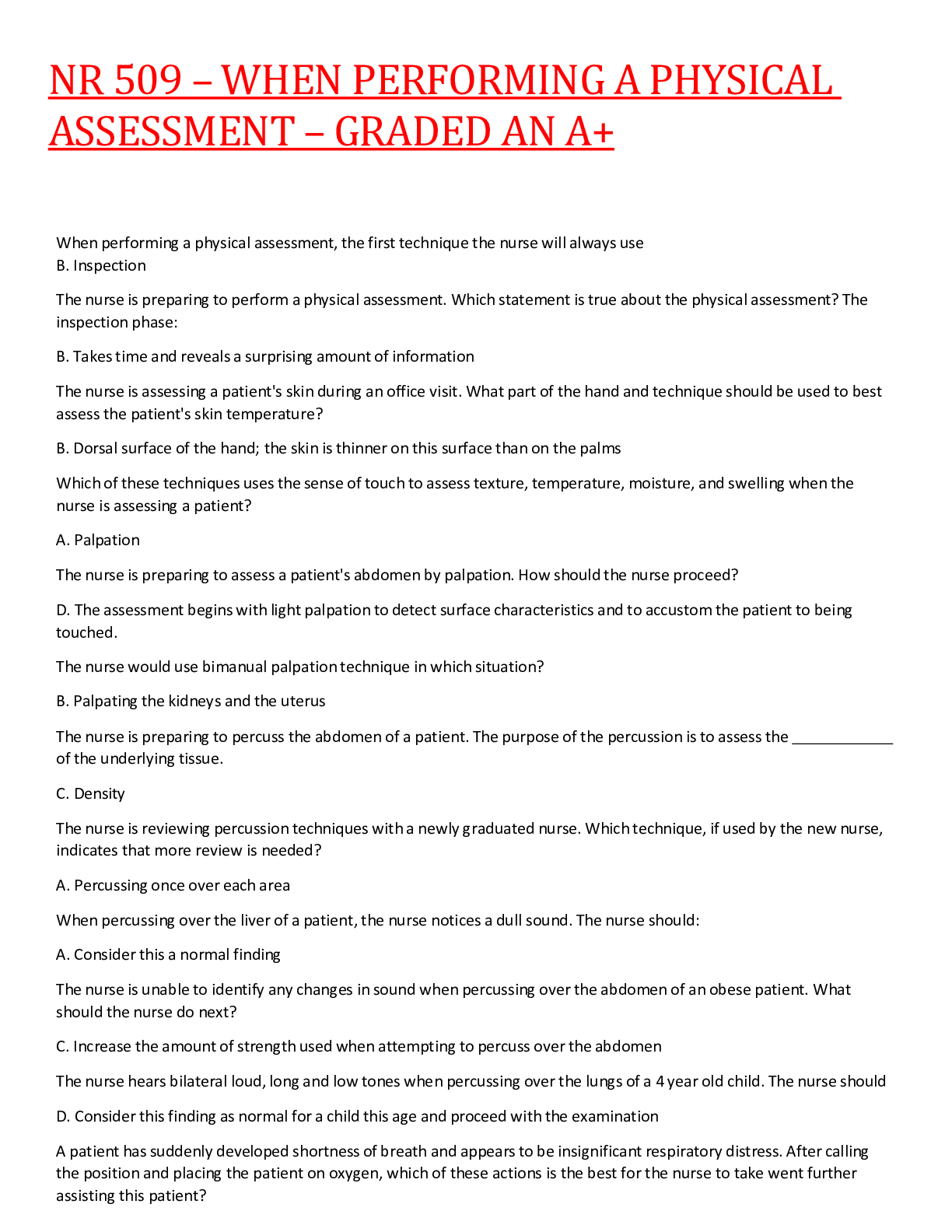
Reviews( 0 )
Document information
Connected school, study & course
About the document
Uploaded On
Feb 01, 2024
Number of pages
41
Written in
Additional information
This document has been written for:
Uploaded
Feb 01, 2024
Downloads
0
Views
36
